Prev Page--Shore Airport Formation || Next Page--Mississippian
Lithostratigraphy of the Hugoton and Stevens Members of the St. Louis Limestone and the Ste. Genevieve Limestone (Upper Mississippian), Southwestern Kansas
by F. E. Abegg
Abstract
The Hugoton and Stevens Members are new lithostratigraphic units of the St. Louis Limestone in the Hugoton embayment, southwestern Kansas. A core from the Mobil #1 Foster (sec. 5, T. 34 S., R. 36 W.) is proposed as the type section for both members.
The Hugoton is the lower member and at the type section contains primarily dolomitic peloidal grainstone/packstone, dolomite, and anhydrite. Breccia, algal boundstone, and dolomitic lime mudstone are common facies elsewhere in southwestern Kansas. The Hugoton Member is easily differentiated from skeletal and oolitic limestones of the uppermost Salem Limestone. Abundant peloids, anhydrite, and paucity of stenohaline marine organisms in the Hugoton Member indicate deposition in a restricted lagoon. Restricted conditions probably resulted from oolite-skeletal shoals in the underlying Salem.
Strata of the Stevens Member contain dominantly skeletal packstone/wackestone. Periodic winnowing, intercalated oolites, and a diverse and abundant assemblage of stenohaline echinoderms, brachiopods, and bryozoans indicate Stevens skeletal packstone/wackestone was deposited in a normal-marine shelf environment at or near fair-weather wave base. Stevens Member oolitic grainstone/packstone, the reservoir facies, accumulated in a highly agitated, marine-shoal environment, probably at depths less than 15 ft (5 m). A quartzose grainstone 3.8 ft (1.2 m) thick in the Stevens Member contains abundant rhizoliths and ubiquitous climbing translatent strata with dips less than T, indicating deposition in a vegetated eolian sand sheet.
Ste. Genevieve strata are recognized by the lowest prominent quartz-rich grainstone. In the Mobil #1 Foster, the basal quartzose grainstone is 9.4 ft (2.9 m) thick, lacks rhizoliths, and consists of abundant climbing translatent, common grainfall, and minor grainflow stratification in crossbed sets up to 1.5 ft (0.5 m) thick with dips as high as 24°. This crossbedding, climbing trans latent strata, and the apparent absence of vegetation indicate deposition by eolian dunes. The overlying Shore Airport Formation typically contains argillaceous limestone and intercalated calcareous shale.
Introduction
Ooid grainstones in the St. Louis and Ste. Genevieve Limestones are important hydrocarbon reservoirs. Despite the economic importance, the lithostratigraphy of these units in southwestern Kansas has not been updated since the work of Goebel (1968a) and Thompson and Goebel (1968). Mississippian strata in Kansas are confined to the subsurface, with the exception of outcrops of Burlington-Keokuk and Warsaw Limestones (Osagean to Meramecian) in two townships of Cherokee County, in the extreme southeastern corner of the state (Thompson and Goebel, 1968; Kammer et al., 1990; Maples, this volume). Upper Mississippian lithostratigraphic nomenclature of the Mississippi Valley region was originally extended to the subsurface of Kansas by Lee (1940) and Clair (1948, 1949).
Most previous studies of Upper Mississippian strata in southwestern Kansas used insoluble residues and biostratigraphy extensively to define lithostratigraphic units. It is more practical to base definitions on the more abundant carbonate fraction that is observable in cores and cuttings, or indicated with certain wireline logs. Formations are rock-stratigraphic units (i.e. lithofacies); accordingly biostratigraphic data should serve to constrain lithostratigraphic correlations, but not to delineate formations. Recent advances in carbonate petrology, sequence stratigraphy, and subsurface data warrant an update of existing lithostratigraphic definitions and interpretations of depositional history of the Upper Mississippian in southwestern Kansas. Increased understanding of Upper Mississippian facies, lithostratigraphy, and depositional history should enhance hydrocarbon exploration and production from these strata.
Ste. Genevieve and St. Louis strata of the Illinois basin and southwestern Kansas share many similarities; however, differences between the two areas exist. Lithologic similarities and entrenched usage in the literature and in the petroleum industry warrant continued use of these formational names in Kansas. This paper aims to update facies descriptions and standardize stratigraphic terminology, as well as increase our understanding of the depositional history for the St. Louis and Ste. Genevieve Limestones.
The core from the Mobil #1 Foster (fig. 1, sec. 5, T. 34 S., R. 36 W., Stevens County, 6 mi (10 km) southeast of Hugoton, Kansas) is proposed as the type section for the Hugoton and Stevens Members of the St. Louis Limestone (fig. 2). In addition, this well will also serve as a reference section for the Ste. Genevieve Limestone in southwestern Kansas. A core is designated as the type and reference section because both the Ste. Genevieve and St. Louis do not crop out anywhere in the state. The Foster core contains facies that are representative of these lithostratigraphic units over much of the Hugoton embayment of southwestern Kansas.
Figure 1—Location of the Mobil #1 Foster (sec. 5, T. 34 S., R. 36 W., southern Stevens County) and other cores used in research of Upper Mississippian strata in southwestern Kansas (cf. Abegg, 1992).
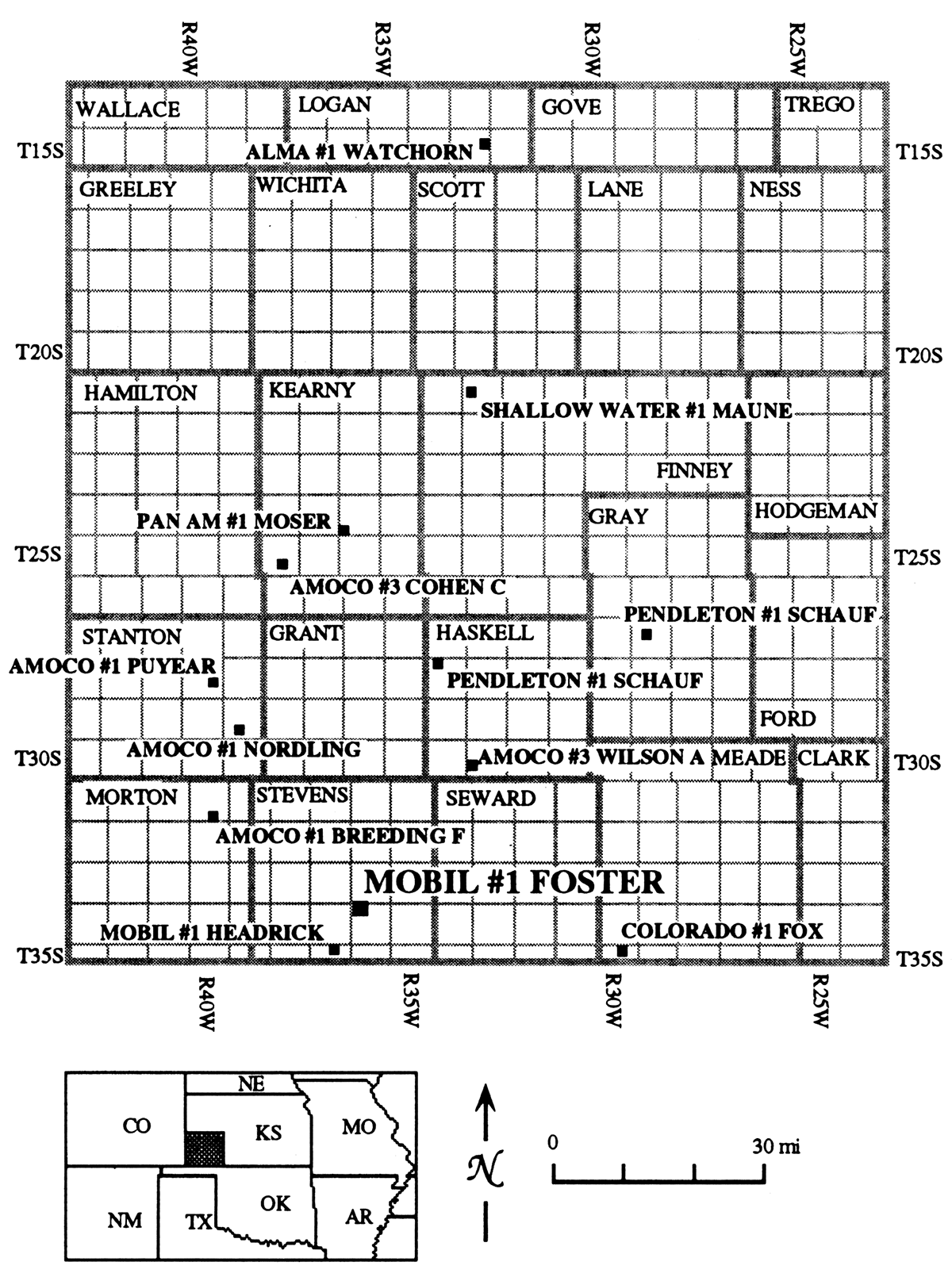
The Mobil #1 Foster core contains 285 ft (87 m) of the Hugoton and Stevens Members of the St. Louis and the Ste. Genevieve (6,625 to 6,910 ft [1,987-2,073 m]). The core is currently housed at the Kansas Geological Survey core facility in Lawrence, Kansas. The base of this core was incorrectly identified as Salem on the scout card and by Abegg (1991). Stratigraphic cross sections indicate the basal 56 ft (17 m) of the core is the marine carbonate unit between the E1 and E2 evaporite of the Hugoton Member (Abegg, 1992). Log depths and core depths are approximately coincident (fig. 3). Neither the Salem-St. Louis nor the Ste. Genevieve-Shore Airport boundaries were cored. In addition to length, this core was selected because it is available to the general public and contains facies representative of these lithostratigraphic units overmuch of the Hugoton embayment.
The type section of the Hugoton Member does not contain the Salem-St. Louis boundary. Principal reference cores, therefore, are needed to facilitate recognition of this boundary. The lower boundary of the Hugoton Member is cored in the Atlantic #1 Mark A, sec. 28, T. 20 S., R. 33 W., Scott County, Kansas (Thompson and Goebel, 1968), and is currently housed at the Kansas Geological core facility in Lawrence, Kansas. Amoco #1 Nordling and Amoco #3 Wilson A (Abegg, 1992) cores also contain the Salem-St. Louis boundary and are currently housed at Amoco's core facility in Denver, Colorado.
Previous Investigations
According to Lee (1940), upper Meramecian and Chesterian strata of southwestern Kansas were first penetrated by the Watchorn Oil and Gas Company #2 Morrison in Clark County in 1931. Strata of "late Meramecian age" in southwestern Kansas were initially grouped into the Watchorn Formation "where subdivision of &ellip; the Spergen [Salem], St. Louis, and possibly Ste. Genevieve limestones is impracticable" (Lee, 1940, p. 84-85). Lee relied heavily on insoluble residues to assist in recognition of Mississippian units. In the same report, Girty (1940) reported on the megafossils of the Watchorn and unnamed Chesterian strata.
Clair (1948, 1949) subsequently divided the Watchorn into three formations using Mississippi Valley nomenclature. Recognition of the Ste. Genevieve, St. Louis, and Spergen (Salem) Limestones was based primarily on lithologic criteria. Chesterian strata (above the Ste. Genevieve) were not named due to lithologic heterogeneity (Clair, 1948, 1949; Beebe, 1959a, 1959b). Thompson and Goebel (1963, 1968) and Goebel (1968a) defined Mississippian strata using a combination of lithologic criteria, insoluble residues, and conodont biostratigraphy.
The Ste. Genevieve Limestone was placed within the Meramecian Stage (e.g., Merriam, 1963; Thompson and Goebel, 1963, 1968; Goebel, 1968b). Recently, however, Maples and Waters (1987) redefined the Meramecian-Chesterian boundary, placing the Ste. Genevieve at the base of the Chesterian Stage, a usage followed in this report (fig. 2).
Figure 2—Upper Mississippian lithostratigraphic units in the Hugoton embayment of the Anadarko basin in southwestern Kansas. Stevens and Hugoton Members of the St. Louis Limestone, Shore Airport Formation (Abegg, this volume) and the informal "Gray group" (Youle, 1991) are new names. The sub-Pennsylvanian unconformity erodes the entire Mississippian section over structural highs (cf. fig. 5). Scale is approximate as thicknesses are variable.
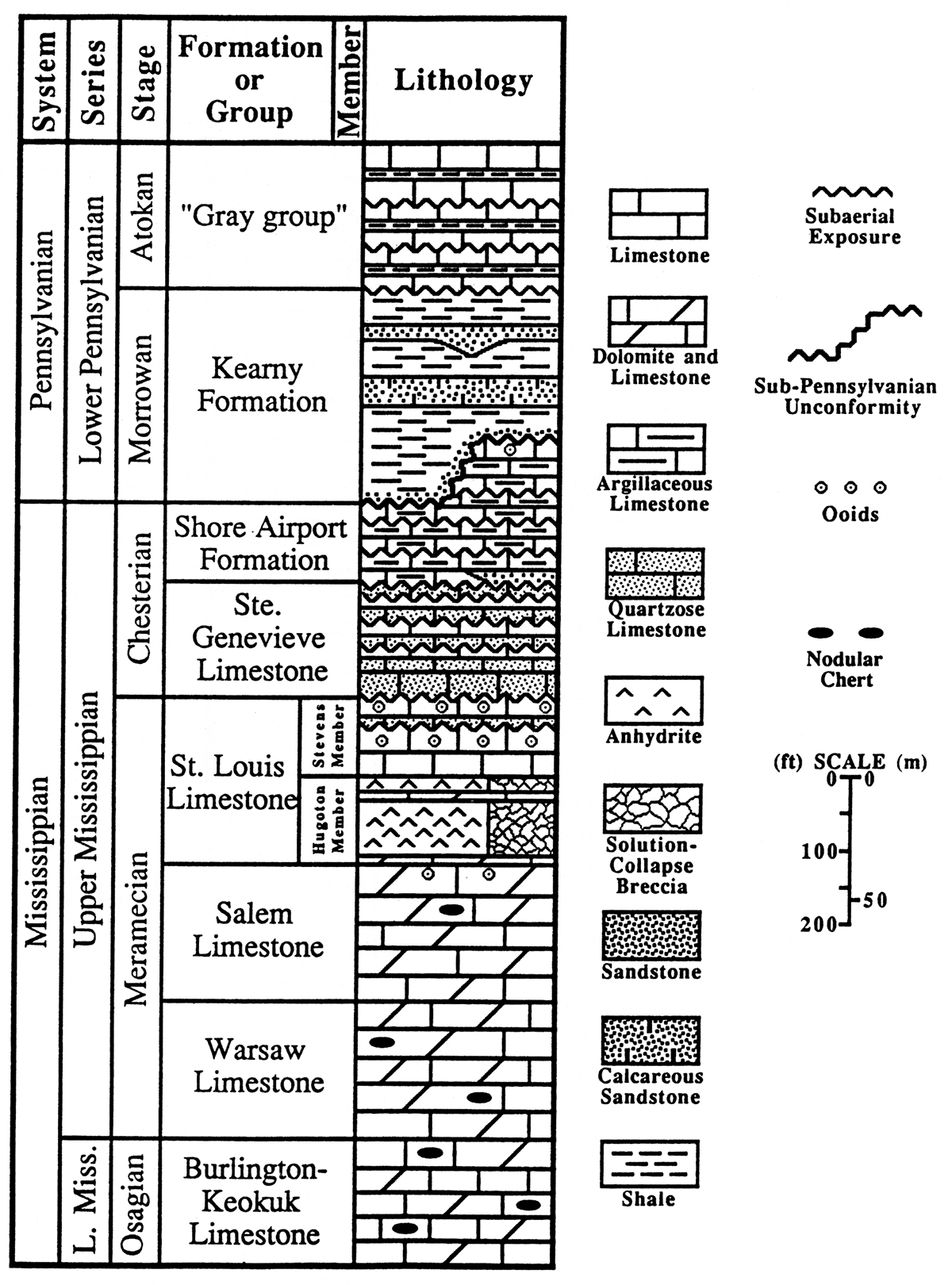
Regional Geology and Stratigraphy
The St. Louis and Ste. Genevieve Limestones are most completely preserved in the Hugoton embayment of the Anadarko basin (figs. 4 and 5). Ste. Genevieve is also preserved in the Forest City basin in northeastern Kansas (Thompson and Goebel, 1968). The St. Louis is more widespread than the Ste. Genevieve and is also preserved in the Forest City, Cherokee, Salina, and Sedgwick basins (Thompson and Goebel, 1968). The nearest St. Louis outcrops are in a down-faulted block along the Chesapeake fault in southwestern Dade and eastern Barton counties, southwestern Missouri (Clark, 1937; Thompson, 1986; personal observation). The nearest outcrops of Ste. Genevieve strata are in the Mississippi Valley, the type area in eastern Missouri (Thompson, 1986).
Ste. Genevieve and St. Louis strata in Kansas were deposited on a carbonate shelf that extended southward from the Transcontinental arch. The shift to argillaceous carbonates and siliciclastics in the overlying Shore Airport Formation marks the termination of dominantly carbonate shelf deposition that continued throughout much of Mississippian time (Lane and De Keyser, 1980). Mississippian strata in Kansas were subaerially exposed and extensively eroded prior to deposition of Lower Pennsylvanian strata.
The Ste. Genevieve (Shumard, 1859) and St. Louis (Engleman, 1847) Limestones were named for exposures in eastern Missouri in the western Illinois basin. In the Mississippi Valley type area, the St. Louis Limestone is primarily a mud-rich carbonate, generally interpreted to have been deposited in restricted lagoonal to tidal flat or sabkha settings (Jorgensen and Carr, 1973; Martorana, 1987). The overlying Ste. Genevieve is oolitic. Ste. Genevieve oolitic carbonates of the Illinois basin are a primary hydrocarbon target, whereas the St. Louis is generally unproductive. In the Hugoton embayment of southwestern Kansas, however, Stevens Member oolites are a major hydrocarbon reservoir, whereas the Ste. Genevieve is less productive.
Definitions of Lithostratigraphic Units
As used in this report, the Salem Limestone is characterized by dolomitic skeletal and oolitic limestones. The overlying St. Louis Limestone is commonly divisible into the Hugoton and Stevens Members (fig. 2). The Hugoton is the lower member and contains primarily peloidal limestone, dolomite, anhydrite, breccia, and algal boundstone. Strata of the Stevens Member are dominantly skeletal limestone. Additionally, uppermost St. Louis strata contain oolitic limestone. This usage differs from the type area where oolitic limestone is included in the Ste. Genevieve. Ste. Genevieve strata are recognized by the lowest prominent quartz-rich limestone, a boundary easily recognized on many neutron-density logs. The overlying Shore AirportFormation (Abegg, this volume) consists primarily of argillaceous limestone and intercalated calcareous shale.
Methods
This report stems from a more comprehensive study (Abegg, 1992) that examines Upper Mississippian strata in the Hugoton embayment of the Anadarko basin (Fig. 1) in southwestern Kansas. The Mobil #1 Foster was originally described at a scale of 1:12. Carbonate textures were described following Dunham (1962). Anhydrite textures were described following Maiklem et al. (1969). A total of 100 thin sections were examined from the Foster core. Stratigraphic cross sections of Shore Airport, Ste. Genevieve, Stevens, Hugoton, and Salem strata will be presented separately (Abegg, 1992).
Figure 3—Gamma ray-sonic log from the Mobil #1 Foster (sec. 5, T. 34 S., R. 36 W.), Stevens County, Kansas. Lithostratigraphic boundaries are picked from a combination of core studies and cross section correlations (SG, Ste. Genevieve; STV, Stevens Member of the St. Louis Limestone; HUG, Hugoton Member of the St. Louis Limestone). Shore Airport (Chesterian) overlies the Ste. Genevieve. Note the extremely clean gamma ray response of the E1 anhydrite (6,854-6,842 ft [2,056-2,053 m]). The St. Louis-Ste. Genevieve boundary is marked by an uphole increase in interval transit time corresponding to an increase in detrital quartz. Cored interval is indicated in depth track. Core and log depths are approximately equal. Depths in feet.
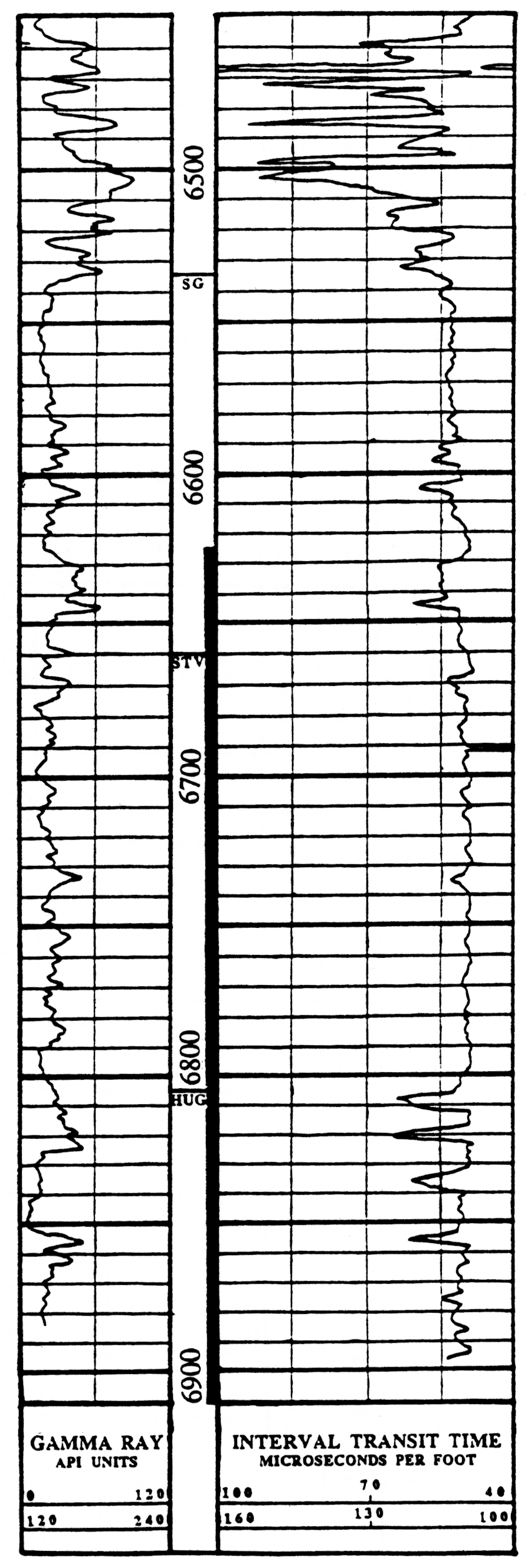
Figure 4—Subcrop map of Mississippian strata beneath the sub-Pennsylvanian unconformity in Kansas (modified from Thompson and Goebel, 1968).
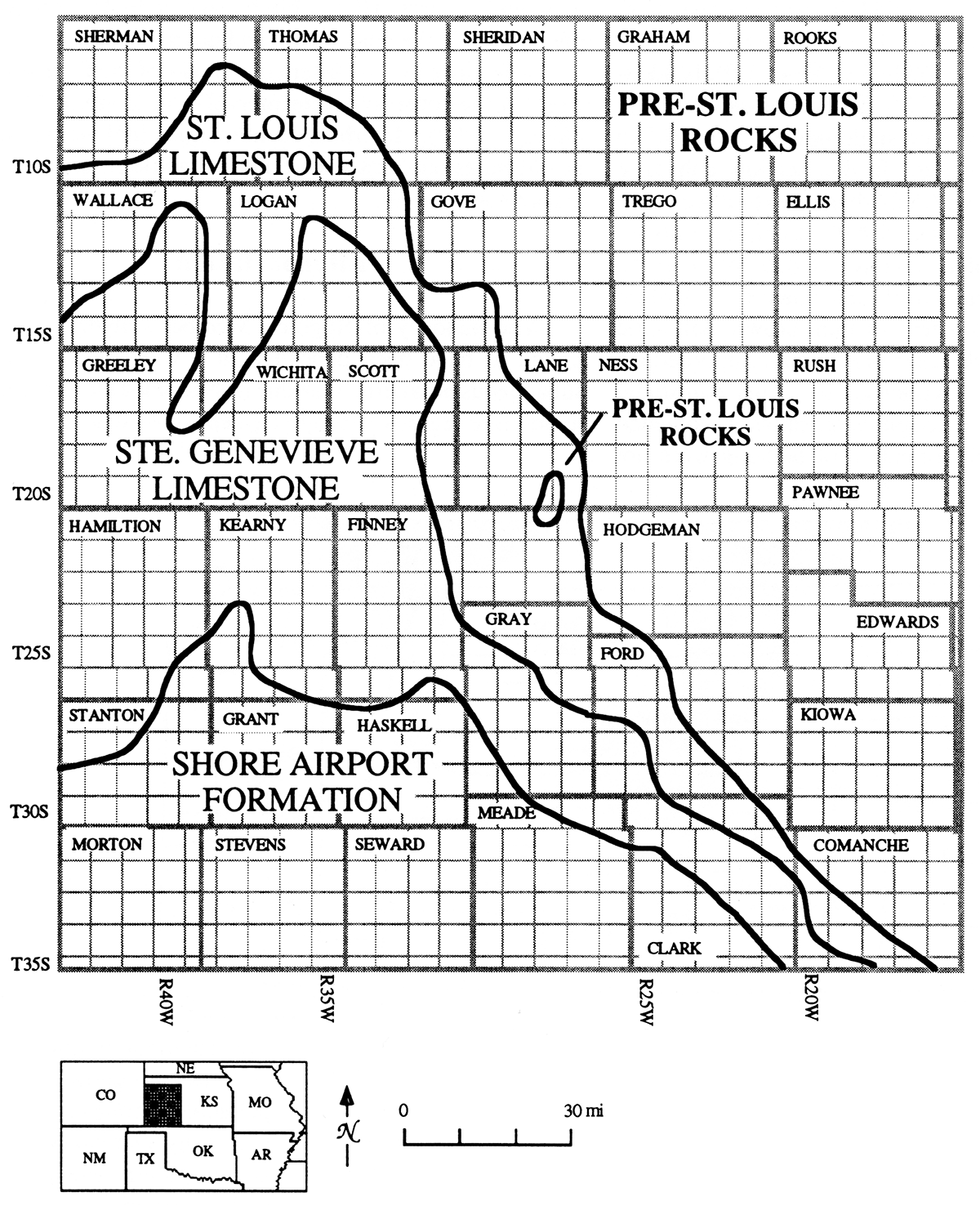
Figure 5—Late Mississippian-early Pennsylvanian tectonic features in Kansas (modified from Merriam, 1963; Ebanks et al., 1979). Shaded areas represent regions where Mississippian strata are absent due to Late Mississippian-Early Pennsylvanian erosion.
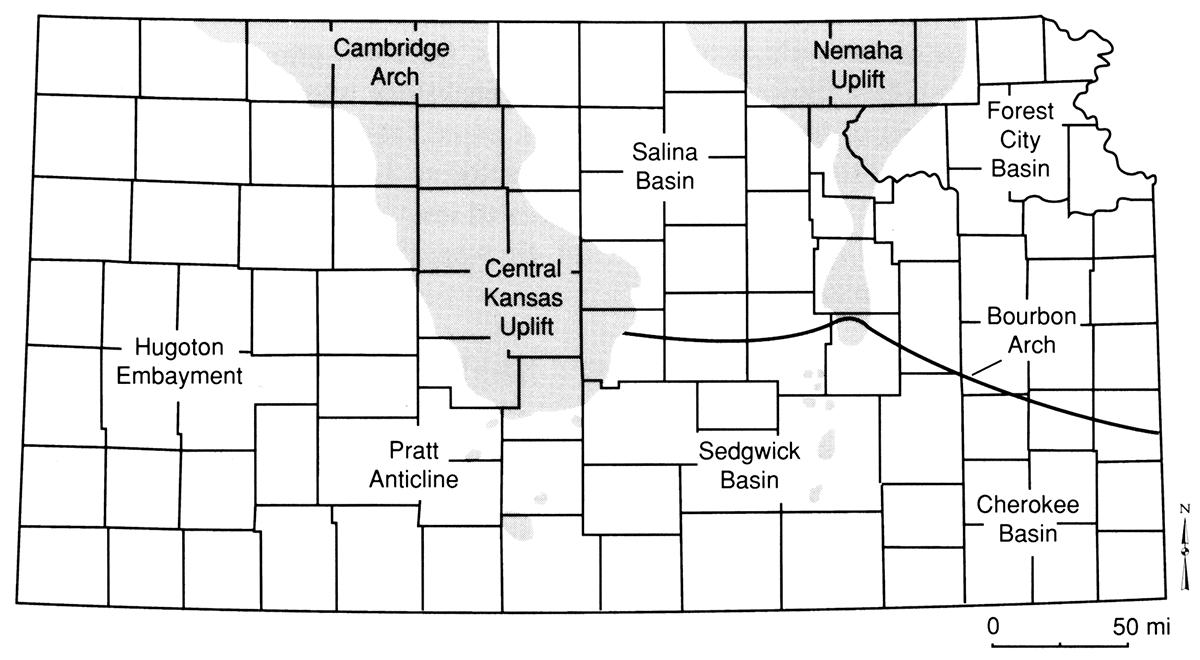
Type and Reference Section Lithofacies and Depositional Environments
Six lithofacies are recognized in the Mobil #1 Foster core (fig. 6): 1) dolomitic peloid grainstone/packstone, 2) anhydrite, and 3) dolomite, 4) skeletal packstone/wackestone, 5) oolitic grainstone/packstone, 6) quartzose grainstone. Breccia, algal boundstone, and dolomitic lime mudstone facies are not present in the type section, but are present elsewhere in the Hugoton embayment (Abegg, 1992). Sedimentology of the St. Louis and Ste. Genevieve Limestones is detailed in Abegg (1992).
Figure 6—Description of core from the Mobil #1 Foster. Wireline log and core depths are roughly equivalent. Right-hand track shows interpretations of shifts in depositional environments. Horizontal dashed lines represent shifts without deposition. Horizontal wavy lines are subaerial exposure surfaces or surfaces bracketing eolian strata. Abbreviations used include the following: SE – subaerial exposure, typically marked by calcretes or eolianites; I – intertidal or tidally influenced, fenestral porosity and tidal rhythmites occur locally; L – restricted lagoon/shelf, evidence of evaporites or absence ofstenohaline marine fossils; SH – oolitic or skeletal shoal, grainstone to mud-poor packstone; SM – shallow marine with evidence of at least intermittent agitation, above or near storm wave base (WB); M – marine with little winnowing, typically wackestone deposited below storm wave base; AD – separates dysaerobic and anaerobic facies from overlying aerobic facies, only present in the Kearny Formation (Morrowan). Depositional textures are also abbreviated: GR – grainstone, PK – packstone, WK – wackestone, LM – lime mudstone. Formations and members are listed in the depth track.
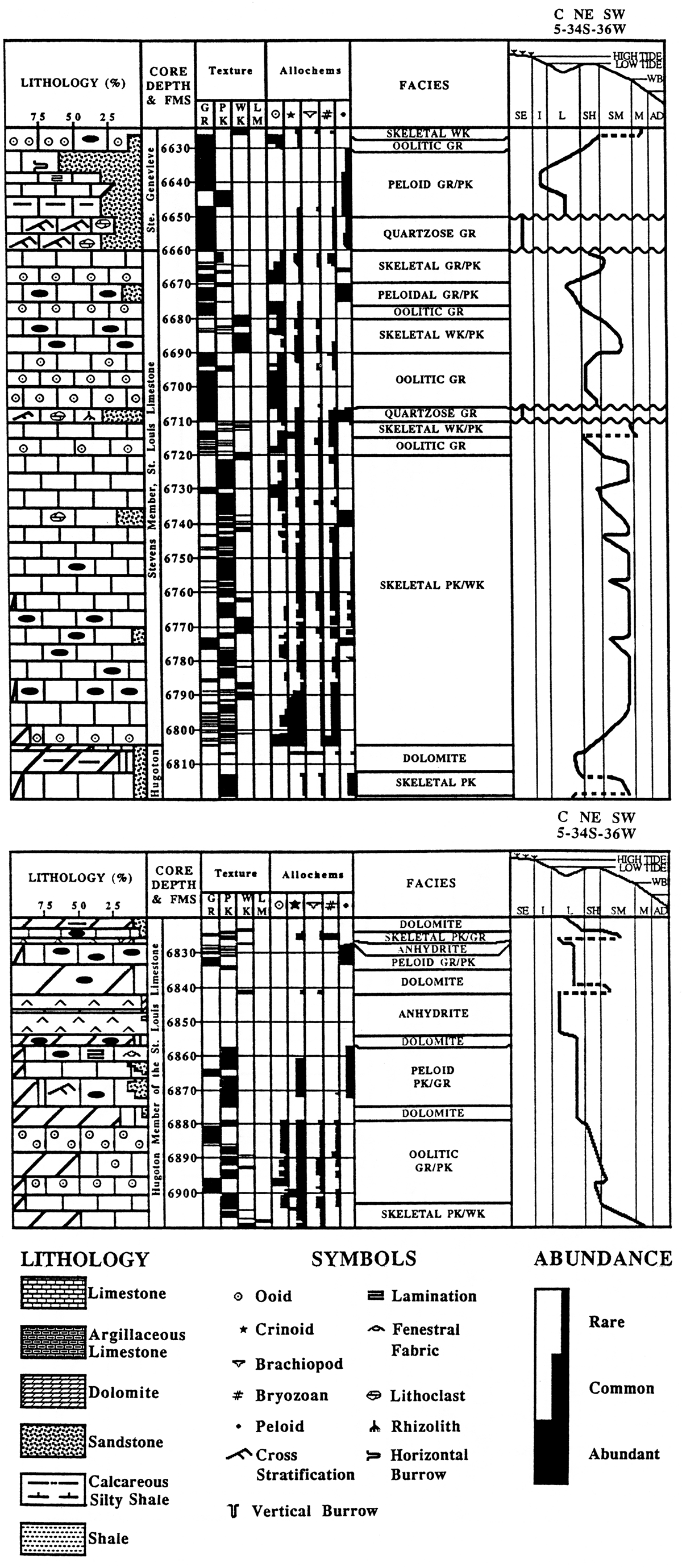
Dolomitic Peloid Grainstone/Packstone
Peloids are abundant to common. Partially micritized allochems suggest that some peloids are micritized grains. Ellipsoidal shape of others suggest they are fecal pellets. Echinoderms are rare to common. Other allochems are rare and include brachiopods, bryozoans, ostracodes, calcispheres, sponge spicules, and intraclasts. Detrital quartz of very fine sand size comprises 5 to 10% of this facies; feldspar, muscovite, glauconite, amphibole, and organic fragments are rare. Dolomite replaces up to 5 to 70% (most commonly 5-30%) of peloid grainstones and packstones. Dolomitization is typically fabric selective, preferentially replacing the micritic fraction. Bluish-gray chert is present in some horizons and is commonly associated with casts of sponge spicules. This suggests a local biogenic source for much of the silica. Cubic pyrite, typically 10 to 50 mm, is scattered throughout much of the facies.
Many intervals are marked by parallel laminae. Some strata are ripple cross laminated (fig. 7). In the Ste. Genevieve at 6,637 to 6,638 ft (1,991.1-1,991.4 m), laminae rhythmically thicken and thin (fig. 8). Horizontal trace fossils are present in some horizons. Possible cryptalgal laminae, oncolites, microfenestral porosity, and autoclastic breccias are present where rocks of this facies occur underneath the anhydrite facies.
Figure 7—Peloid grainstone/packstone facies from the Hugoton Member in the Mobil #1 Foster. Ripple cross laminations highlighted by chert. 6,832 ft core depth.
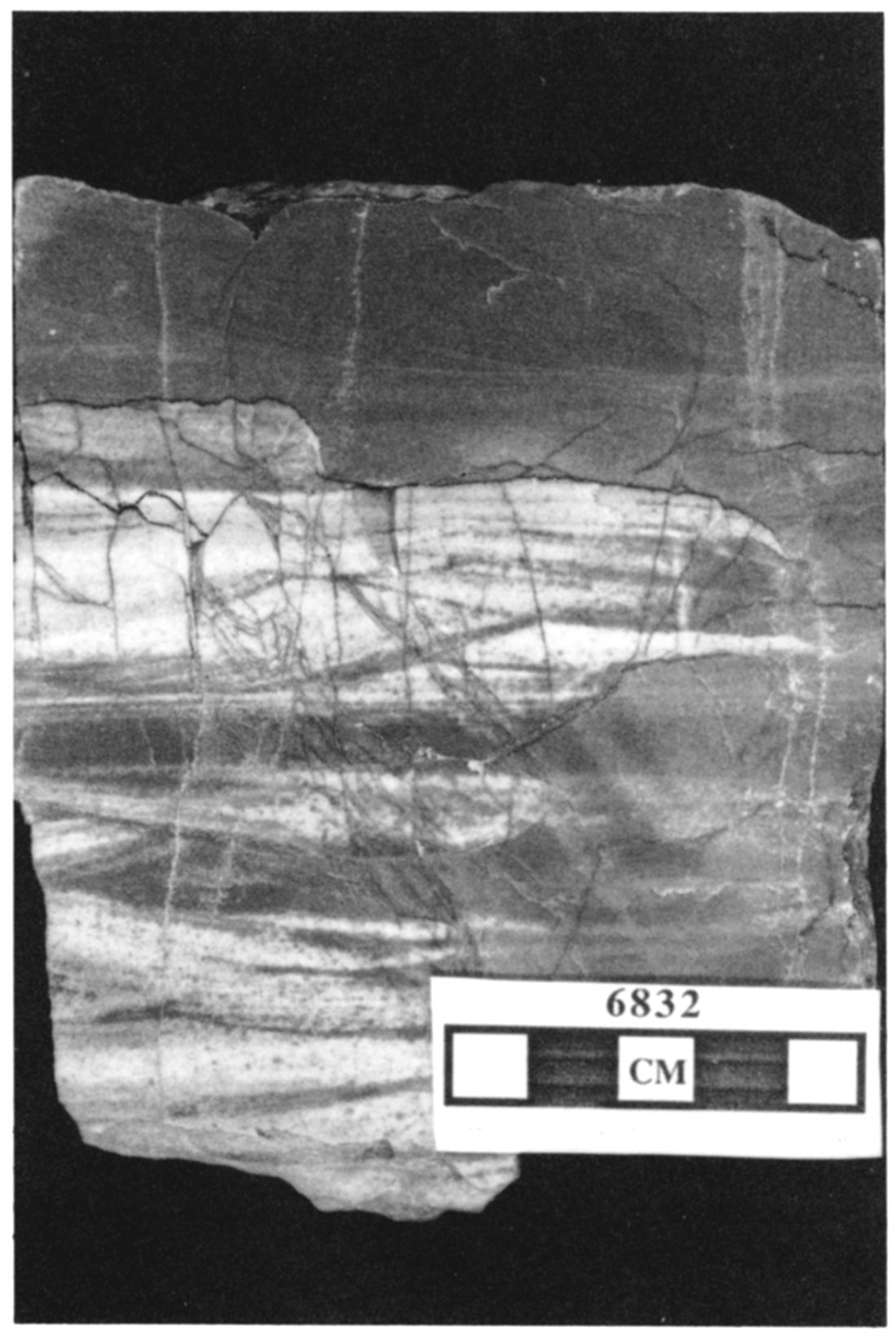
In the Foster core, peloid grainstone/packstone is interstratified with ooid grainstone/packstone, anhydrite, skeletal packstone/wackestone, or quartzose grainstone (fig. 6).
Interpretation
The abundance of peloids, paucity of stenohaline marine organisms, and association with anhydrite suggest peloid packstone and grainstone were deposited in a restricted-shelf setting. Subadjacent oolitic shoals are interpreted to have formed a barrier restricting connections with open-marine waters. Parallel lamination of packs tones indicates low energy. Periods of increased agitation are indicated by ripple cross laminae. Alternating thick and thin laminae (fig. 8) appear similar to tidal rhythmites (A. W. Archer, pers. comm.). Possible cryptalgallaminae, oncolites, microfenestral porosity, and autoclastic breccia suggest shallow water or briefly emergent conditions. Diagnostic evidence for subaerial exposure (cf. Esteban and Klappa, 1983), however, is absent.
Figure 8—Peloid packstone from the Ste. Genevieve in the Mobil #1 Foster. Systematic thickening and thinning of laminae appear similar to tidal rhythmites (A. W. Archer. pers. comm.). 6,637-6,638 ft core depth.
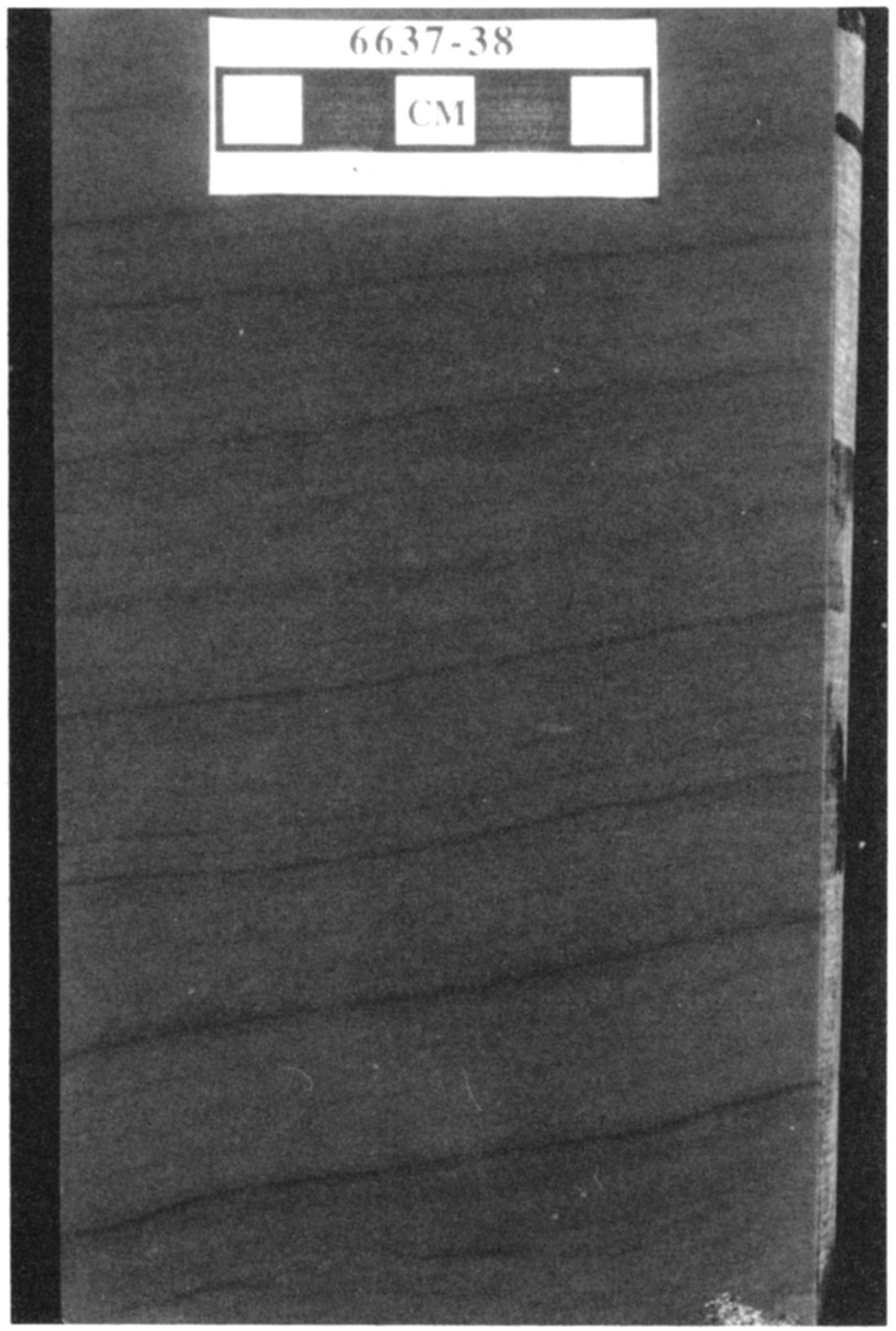
Anhydrite
Anhydrite occurs at two horizons in the Stevens Member of the St. Louis in the reference core (fig. 6). Anhydrite textures in the reference section are predominantly mosaic (e.g. 6,843.5 to 6,844.0 and 6,853 ft) and massive (e.g. 6,848.2 to 6,848.9 and 6,851 ft) (fig. 9, cf. Maiklem et al., 1969). Nodular-mosaic (e.g. 6849.3 to 6,849.5 ft), bedded-nodular (e.g. 6,826.85 to 6,827.0 ft), bedded-mosaic (e.g. 6,826.55 to 6,826.85 ft), and crystallotopic (e.g. 6,849.5 to 6,849.6 ft) textures also occur. In thin section, anhydrite textures are mostly felted, with lath-shaped texture occurring less frequently (cf. Maiklern et al., 1969). Blocky crystals are observed in anhydrite-filled fractures (6,839 to 6,840 ft). Much of the anhydrite contains little or no matrix. Anhydrite nodules are outlined by a matrix of thin, brown, dolomitic peloidal carbonates. Carbonates are typically interbedded with anhydrite intervals. Nodules are generally ellipsoidal and irregularly arranged, although vague upward-elongated nodules occur locally. Stratification or bedding were not observed. The edges of anhydrite nodules are commonly partially replaced by light-blue, length-slow, spherulitic chalcedony (cf. Folk and Pittman, 1971) and rarely by euhedral authigenic quartz. Highly birefringent anhydrite relicts are uncommon in the chalcedony and quartz.
Anhydrite in the Foster core is part of the E1 evaporite (fig. 10), the upper anhydrite interval in the Hugoton Member (Abegg, 1992). Interbedded lithologies include dolomitic peloid grainstone/packstone, dolomite, and skeletal packstone/wackestone (fig. 6).
Figure 9—Anhydrite textures from the E1 anhydrite of the Hugoton Member in the Mobil #1 Foster. Massive (M) and mosaic (Mo) (cf. Maiklem et al., 1969) are the most abundant structures. Possible vertically elongated anhydrite nodule (arrow) may represent a relict vertical gypsum crystal. 6.842-6,844 ft core depth.
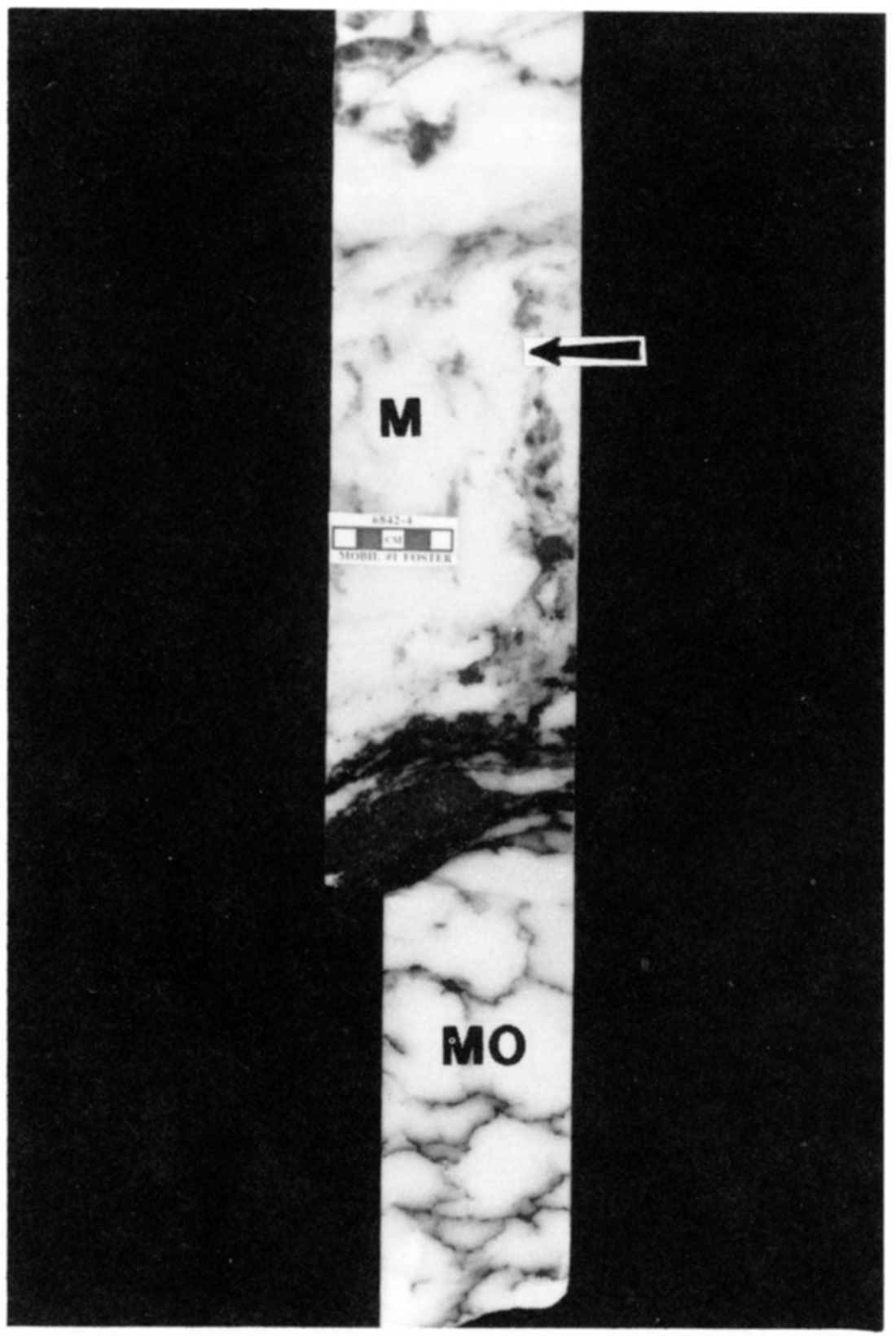
Figure 10—North-south stratigraphic cross section of the Hugoton Member anhydrite. Most E2 anhydrite beds do not extend as far south as E1 anhydrite.
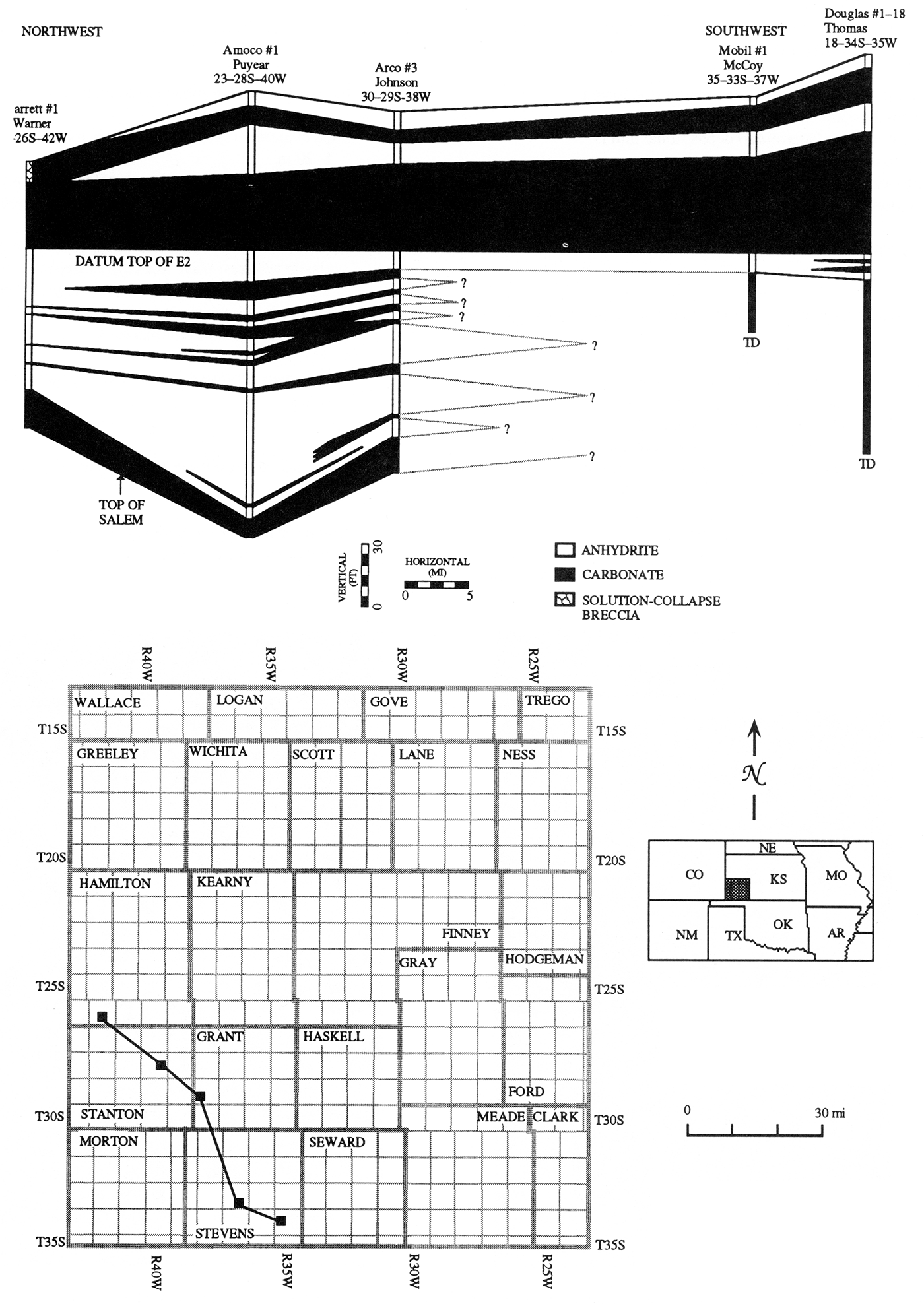
Interpretation
The majority of Hugoton Member anhydrite is interpreted to have been deposited in a widespread shallow-subaqueous or saltern. Warren (1989) coined the term saltern to describe regions of evaporite deposition that are laterally more extensive than salinas or evaporating pans. Salterns have no known modern analog.
Mosaic, nodular-mosaic, and massive textures are abundant in the St. Louis Limestone evaporites. Such textures are commonly genetically associated with sabkha environments (Kerr and Thomson, 1963). Numerous authors, however, have indicated such associations are not always warranted (Dean et al., 1975; Warren and Kendall, 1985; Warren, 1989, 1991). Many differences exist between sabkha and saltern evaporites (table 1). The thickness, lateral extent, and lack of significant carbonate matrix of the anhydrite, as well as interbedded, shallow-water carbonate, indicate most of the anhydrite was originally deposited as gypsum in a saltern (table 1). Diagnostic supratidal features (cf. Shinn, 1983) are extremely rare.
Table 1—Distinguishing features of sabkha and saltern (extensive shallow-subaqueous) evaporites (modified from Warren, 1989, his table 3.1).
| Sabkha | Salter |
|---|---|
| Evaporite units are supratidal, matrix dominated, usually <60% sulfate Each evaporite (supratidal) depositional unit is thin, usually 1-2 m Displacive and replacive nodular and enterolithic textures Evaporite crystals are diagenetic Associated with tepees, flat-laminated and mudcracked algal mats Facies units tend to be laterally extensive, parallel to shoreline; deposition marked by subtidal, intertidal, and supratidal strata ("peritidal" trilogy of Warren and Kendall, 1985) Carbonate matrix washed in from lagoon during storms; quartz sands can be blown in from adjacent sand seas (ergs) Dolomitization by storm recharge and shallow brine reflux |
Evaporite units are subaqueous, relatively pure, often > 70% sulfate Each evaporite (subaqueous) unit is thick, 1-20 m Bottom-nucleated evaporite crystal textures; often laminated, laminae can be laterally continuous, but do not extend across the whole basin Deposition can be mechanical; evaporites contain clastic textures: wave and current ripples, crossbeds, rip-up breccias, reverse and normal graded beds Associated with tepees, laminar algal mats, and domal subaqueous stromatolites Facies often symmetric or asymmetric bull's-eye facies Carbonate facies outline areas of less saline water in basin Dolomitization by evaporite drawdown and deeper brine reflux |
Dolomite
Many carbonates in the Hugoton Member of the St. Louis are dolomitic (Abegg, 1992). However, only a few are extensively dolomitized. This facies is defined as rock containing greater than approximately 70% dolomite, which typically obscures the original depositional texture. Dolomitization is highly fabric selective, preferentially replacing the micritic fraction of the rock. The dolomite typically consists of finely crystalline (l0 to 15 mm), limpid crystals with euhedral to planar-s texture (cf. Sibley and Gregg, 1987). Floating within this finely crystalline dolomite are dolomite rhombs up to 350 mm with planar-e texture (cf. Sibley and Gregg, 1987). Saddle-dolomite (nonplanar) cements are rare. Extensive dolomitization has obliterated most grains, but peloids, crinoids, brachiopods, and fenestrate bryozoans are preserved in a few beds. Interbedded less dolomitized carbonates contain peloids, crinoids, brachiopods, bryozoans, foraminifera, and intraclasts.
Up to 10% detrital quartz sand and silt is present in some dolomite horizons. Parallel lamination is common in many horizons and is locally disrupted by horizontal burrows (fig. 11). Sutured and unsutured stylolites, fractures, and chert nodules occur locally.
The dolomite facies is interbedded with the anhydrite, peloid grainstone/packstone, and skeletal packstone/wackestone facies (fig. 6). In addition, underlying Salem Limestone carbonates are also commonly dolomitic.
Figure 11—Dolomite facies from the Hugoton Member in the Mobil #1 Foster. Parallel laminae are partially to totally disrupted by burrows. 6,808 ft core depth.
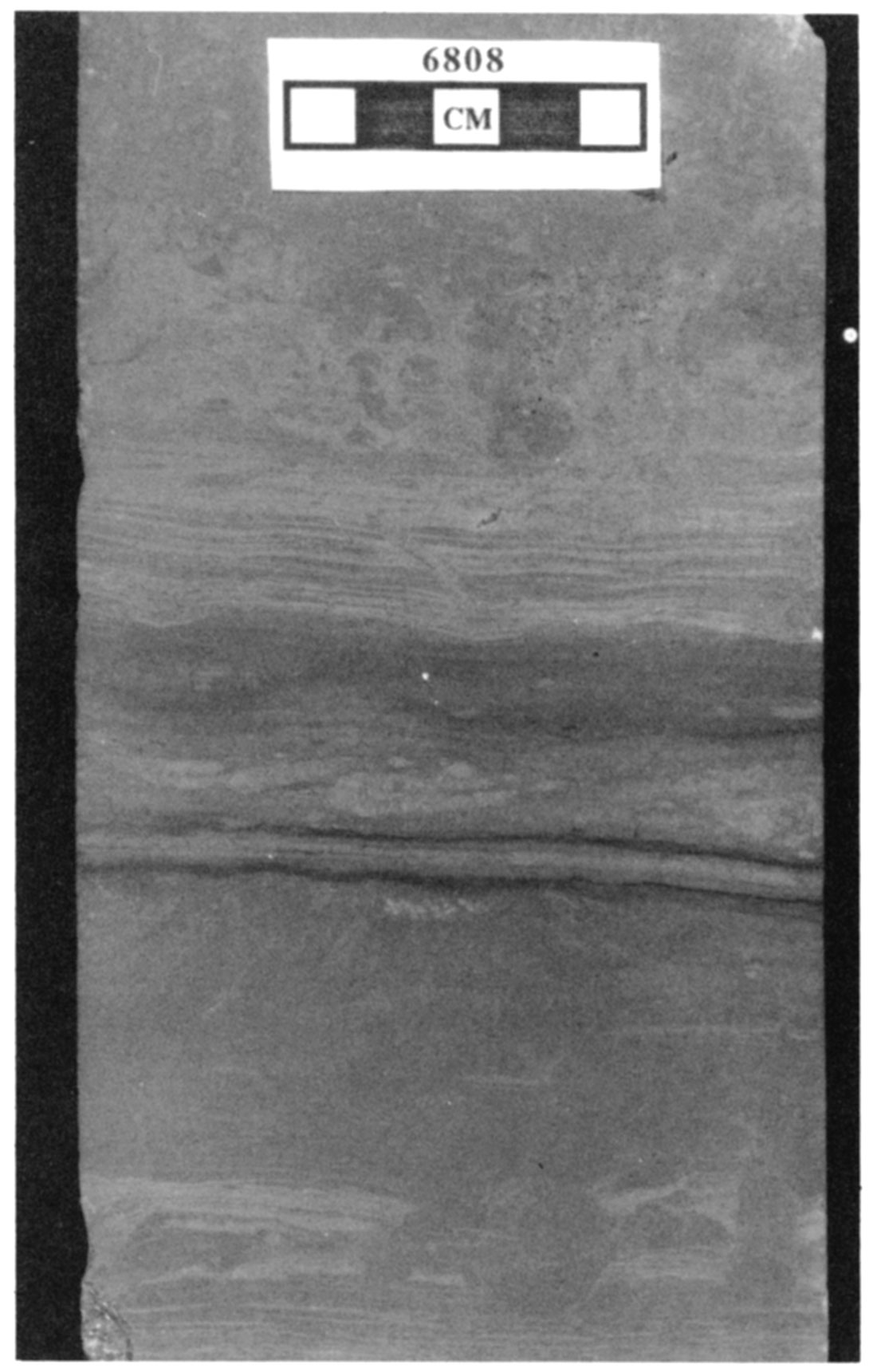
Interpretation
Rare stenohaline marine crinoids, brachiopods, and fenestrate bryozoans preserved in dolomite indicate local marine deposition of the precursor. Common laminations and detrital quartz suggest some dolomitized beds are altered peloid packstone. Because dolomitization is fabric selective for matrix, however, packstone and grainstone are likely to be less dolomitized. Therefore, extensively dolomitized facies probably had a micrite-rich precursor. The fine-grained nature of much of the dolomite supports such an interpretation.
Dolomitic carbonate is intercalated or laterally correlative to anhydrite and solution-collapse breccia in the Hugoton Member. Most strata in the overlying Stevens Member contain little or no dolomite, even though muddy facies are present. This relationship suggests evaporitic brines were responsible for much of the dolomitization, possibly due to refluxing lagoonal brines or connate brines expressed during compaction. Minor baroque dolomite indicates some deeper burial dolomitization. Additional investigation is needed to determine the genesis of dolomite in the Hugoton Member.
Skeletal Packstone/Wackestone
Skeletal packstone/wackestone is the most extensive facies in the Stevens Member of the St. Louis Limestone. Echinoderms and bryozoans are abundant to rare. Common to rare allochems include brachiopods and ooids. Rugose and tabulate corals, bivalve? and gastropod casts, trilobite fragments, foraminifera (mainly endothyrids), ostracodes, siliceous sponge spicules, and worm tubes are rare (fig. 12). Detrital quartz is generally absent to very rare, but makes up to 20% of the rock locally. Horizontal burrows are common in some intervals, whereas vertical burrows are rare. Truncated allochems, commonly capped by a vaguely laminated peloidal micritic crust, occur along subhorizontal surface locally in mud-poor packstones (fig. 13).
Figure 12—Skeletal packstone/wackestone from the Stevens Member in the Mobil #1 Foster. Microstylolites (M), burrow (Bu), bryozoans (Br), solitary rugose coral (RC), and crinoids (C) are indicated by arrows. 6,747-6,748 ft core depth.
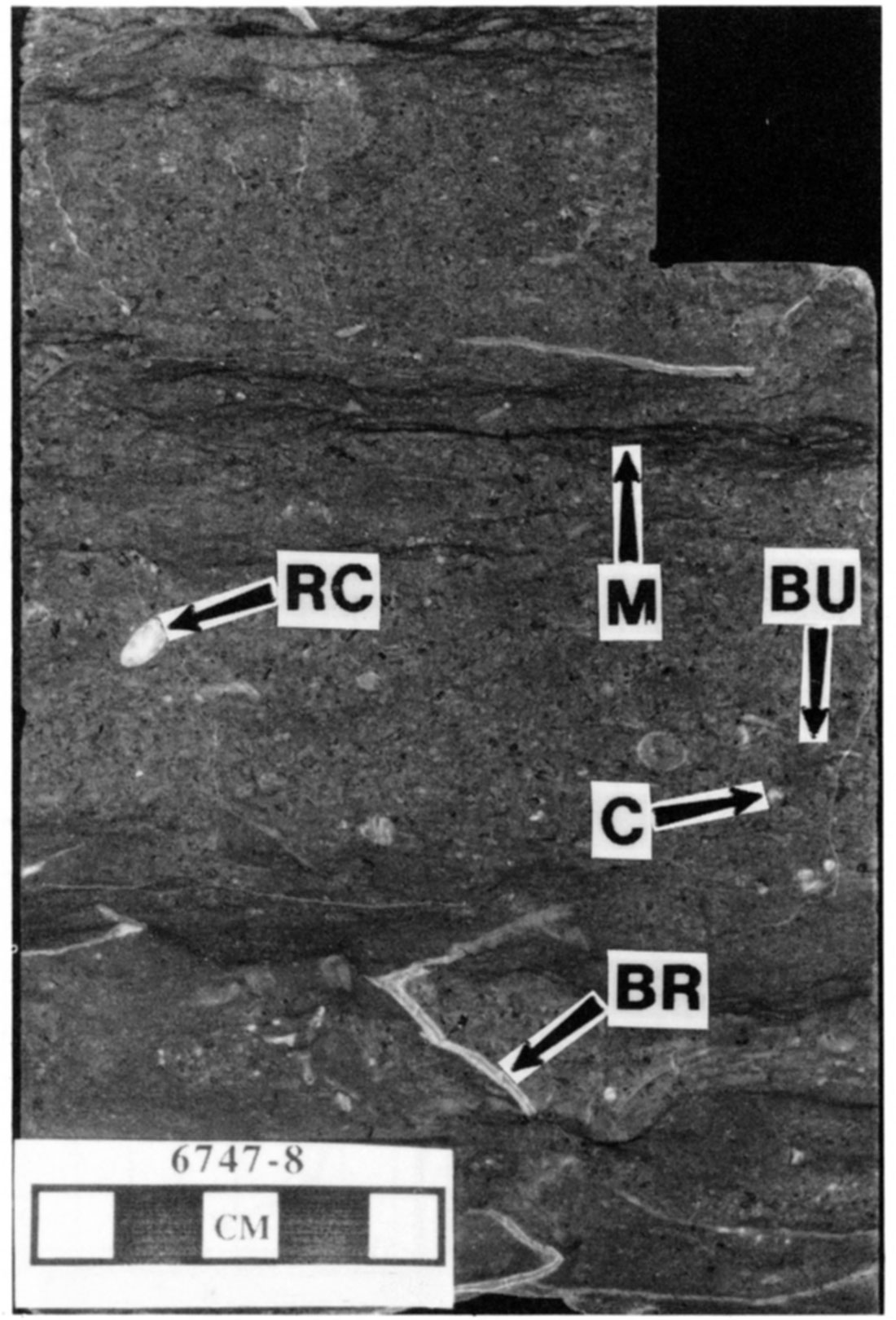
Figure 13—Two hardgrounds in skeletal and oolitic, mud-poor packstones from the Stevens Member in the Mobil #1 Foster. Note the relief on the upper hardground surface. The upper hardground is overlain by a vaguely laminated peloidal crust (arrow) that is possibly algal in origin. 6,715 ft core depth.
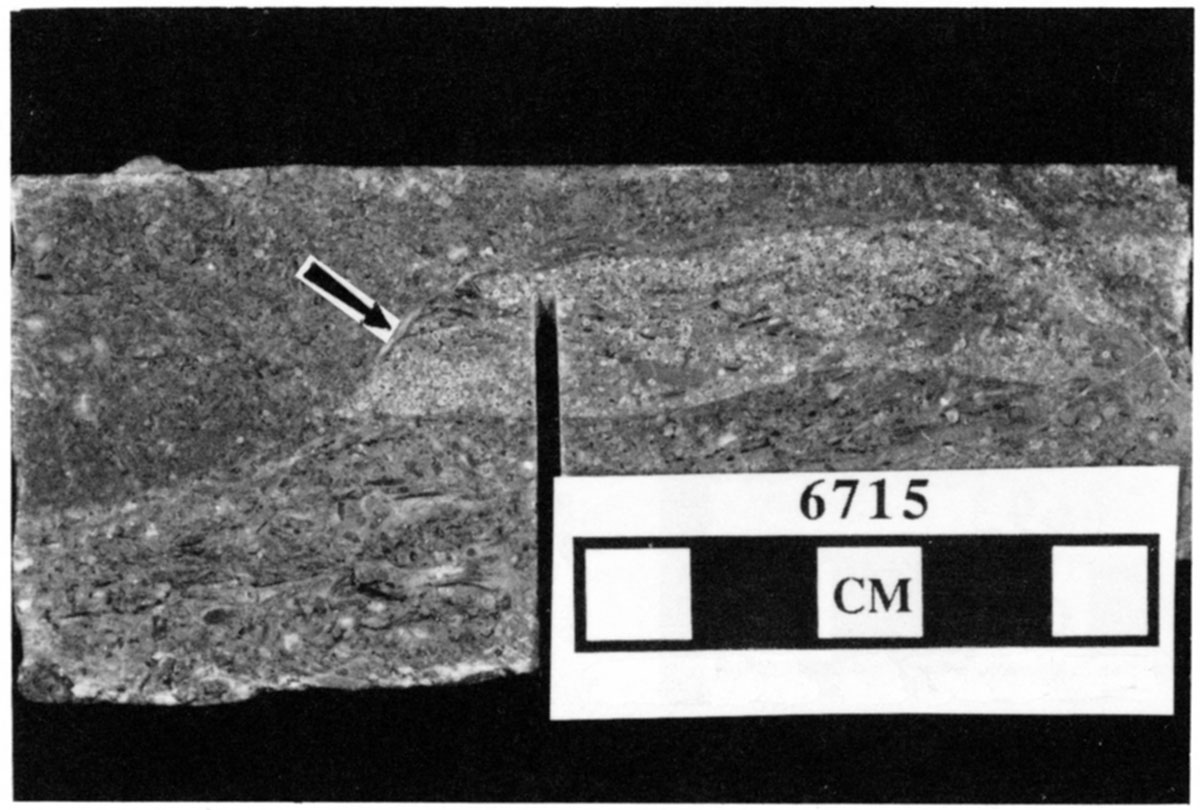
Skeletal packstone/wackestone is commonly gray to tan. Chert is generally rare and typically bluish-gray in color. Sponge spicules, now casts filled by sparry calcite and silica cement, provided a biogenic source for much of the silica. Absence of significant grain interpenetration within chert nodules and deflection of stylolites around chert nodules indicate that chert is precompactional. Dolomite is a minor constituent and is best developed proximal to Hugoton Member anhydrite. Microstylolites, and less commonly sutured stylolites, are present throughout much of this facies (fig. 12). Sutured and concave-convex interpenetrating grain contacts indicate significant pressure solution locally.
Many skeletal packstone/wackestone intervals are overlain by oolitic grainstone/packstone. The skeletal packstone/wackestone facies is also intercalated with the dolomite, anhydrite, and peloid grainstone/packstone facies of the St. Louis Limestone, and the quartzose grainstone of the Ste. Genevieve Limestone (fig. 6).
Interpretation
The diverse and abundant assemblage of stenohaline echinoderms, brachiopods, and bryozoans indicate deposition in a normal-marine environment. Periodic winnowing and intercalated oolites suggest deposition at or above fair-weather wave base. An abundance of horizontal trace fossils, characteristic of the Cruziana ichnofacies (Seilacher, 1967), is also consistent with shallow-marine deposition. Absence of subaerial exposure features (cf. Esteban and Klappa, 1983) suggest the truncation surfaces are marine hardgrounds.
Oolitic Grainstone/Packstone
Well-sorted, very fine- to coarse-grained ooids dominate this facies (fig. 14). Ooid cortices have a radial-concentric microstructure and are generally unbroken and relatively unabraded. Other allochems are rare and include echinoderms, brachiopods, bryozoans, gastropods, foraminifera, ostracodes, and lithoclasts. Detrital quartz is present only as nuclei of a few ooids.
Figure 14—Ooid grainstone from the Stevens Member in the Mobil #1 Foster. Note scattered lithoclasts (arrow). Crinoids, and to a lesser degree brachiopods. nucleate cements more readily than ooids. Rare uncoated crinoids nucleate syruaxial cements that occlude much of the interparticle porosity. 6,693 ft core depth.
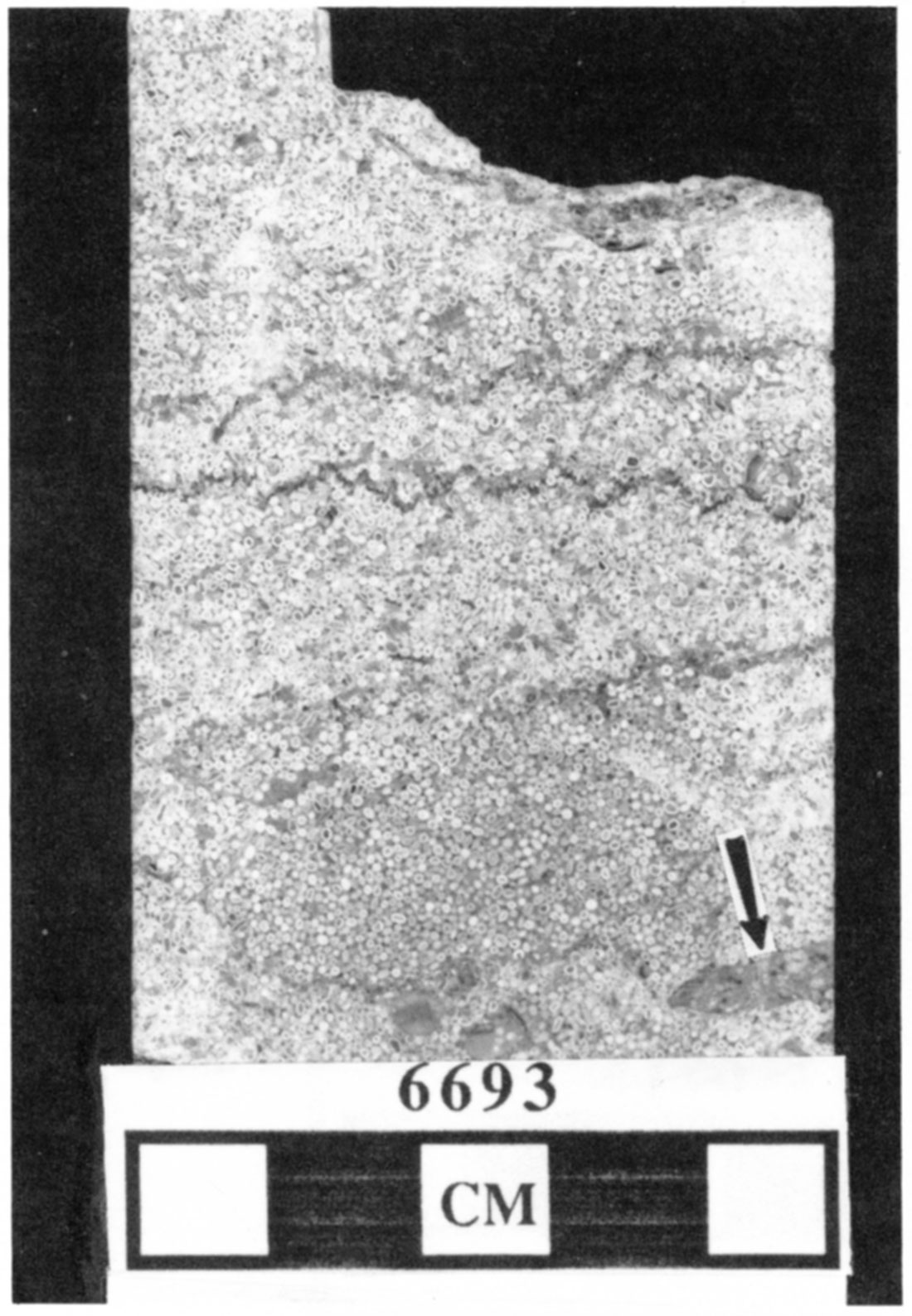
Sedimentary structures are uncommon in many of the oolites. Unidirectional very low angle cross stratification to parallel lamination are present locally. Truncated ooids and bioclasts, commonly capped by a vaguely laminated peloidal micritic crust, occur along subhorizontal surfaces locally (fig. 13). Isopachous bladed cements are commonly well developed below the truncation surface, but are absent above.
This facies is the reservoir facies for most St. Loui Limestone producing intervals. Extant porosity is generally slightly solution-enlarged, cement-reduced interparticle.
The lower contact of the oolitic grainstones and packstones is typically gradational. Many oolites are underlain by skeletal packstone or wackestone. The upper contact of the ooid grainstone/packstone facies is either abrupt or somewhat gradational. Many oolites are overlain by skeletal packstone/wackestone, and rarely by quartzose grainstone and peloid grainstone/packstone (fig. 6). Oolitic grainstone or packstone is most abundant in the upper Stevens Member.
Interpretation
The dominance of ooids and grainstone texture, minor cross stratification, and scattered stenohaline marine fossils indicate that oolitic grainstones and packs tones accumulated in a highly agitated, marine environment. Modern ooids generally form at depths less than 6 ft (2 m), with the majority of ooid-rich facies being deposited in depths less than 15 ft (5 m) (Newell et al., 1960). Near absence of cross stratification may indicate bioturbation. Vaguely laminated, peloidal, micritic crusts with fenestral porosity on oolitic truncation surfaces (fig. 13) may be algal in origin, suggesting they formed with the aid of substrate-stabilizing algal mats (Gebelein, 1969). Absence of subaerial exposure features (cf. Esteban and Klappa, 1983) indicates the micritic crusts are not laminated calcretes. Dravis (1979) reports that algae were important in the formation of oolitic hardgrounds in the Bahamas. Isopachous bladed cements that are present only below the hardground may be marine in origin.
Quartzose Grainstone
Common grains include peloids, echinoderms, bryozoans, and ooids. Brachiopods, foraminifera, and lithoclasts are rare. Glauconitic grains are scattered throughout. Grain size ranges from very coarse silt to medium sand and varies with stratification type. Detrital quartz varies between 5 to 30%. Other detrital grains are rare, including feldspar, zircon, and amphibole.
Allochems are typically broken and well rounded, regardless of their original shape. Detrital quartz is not as well rounded as carbonate grains. In contrast to the ooid grainstone/packstone facies, ooid cortices are commonly noticeably abraded. This was originally reported by Clair (1948, p. 4; 1949, p. 61) as "elliptical rather than round" ooids. Syntaxial cement overgrowths of some echinoderm fragments are extremely well rounded. Quartzose grainstones are well to moderately sorted, but individual laminae are typically well sorted.
Petrography of acid etching and polishing of slabbed cores, as well as thin-sections, indicate grain types are grain-size dependent. The fine- to medium-sand fraction consists of common bioclasts and ooids with a relatively minor peloid and quartz abundance. The very coarse silt to very fine sand fraction consists primarily of detrital quartz and peloids with a relatively minor bioclastic fraction.
Three types of fine structure, the small discernible structural components of a deposit (Hunter, 1977, 1981, 1985, 1989), are recognized in the Mobil #1 Foster from this facies: 1) climbing translatent stratification, 2) indistinct stratification, and 3) structureless to fining-upward units.
Climbing Translatent Strata
The most common fine structure in the quartzose grainstone facies is marked by climbing translatent stratification. They are typically 2 to 5 mm thick, but some are as thick as 9 mm (figs. 15 and 16). Individual strata coarsen upward internally. Ripple foreset lamination is typically rare. Polishing or acid-etching surfaces enhances its recognition. Ripple foreset lamination and upward coarsening are best observed in the thickest strata. Coarsening-upward strata in the Mobil #1 Foster commonly dip at angles less than 7°. Best examples of coarsening-upward strata in the Mobil #1 Foster are at 6,706.3 to 6,706.7 and 6,659.2 to 6,659.9 ft.
Figure 15—Quartzose grainstone in the Stevens Member from the Mobil #1 Foster. A) Climbing translatent strata, interpreted as eolian, dip at approximately 6°. The strata are unusually thick (up to 9 mm), coarsen upward, and contain well-developed rippleforeset lamination. Direction of ripple migration is down the slope or to the right. Note the vertical rhizolith (arrow). B) Photomicrograph of climbing translatent stratification shown in 15A. Scale bar is 1 mm. 6,707 ft core depth.
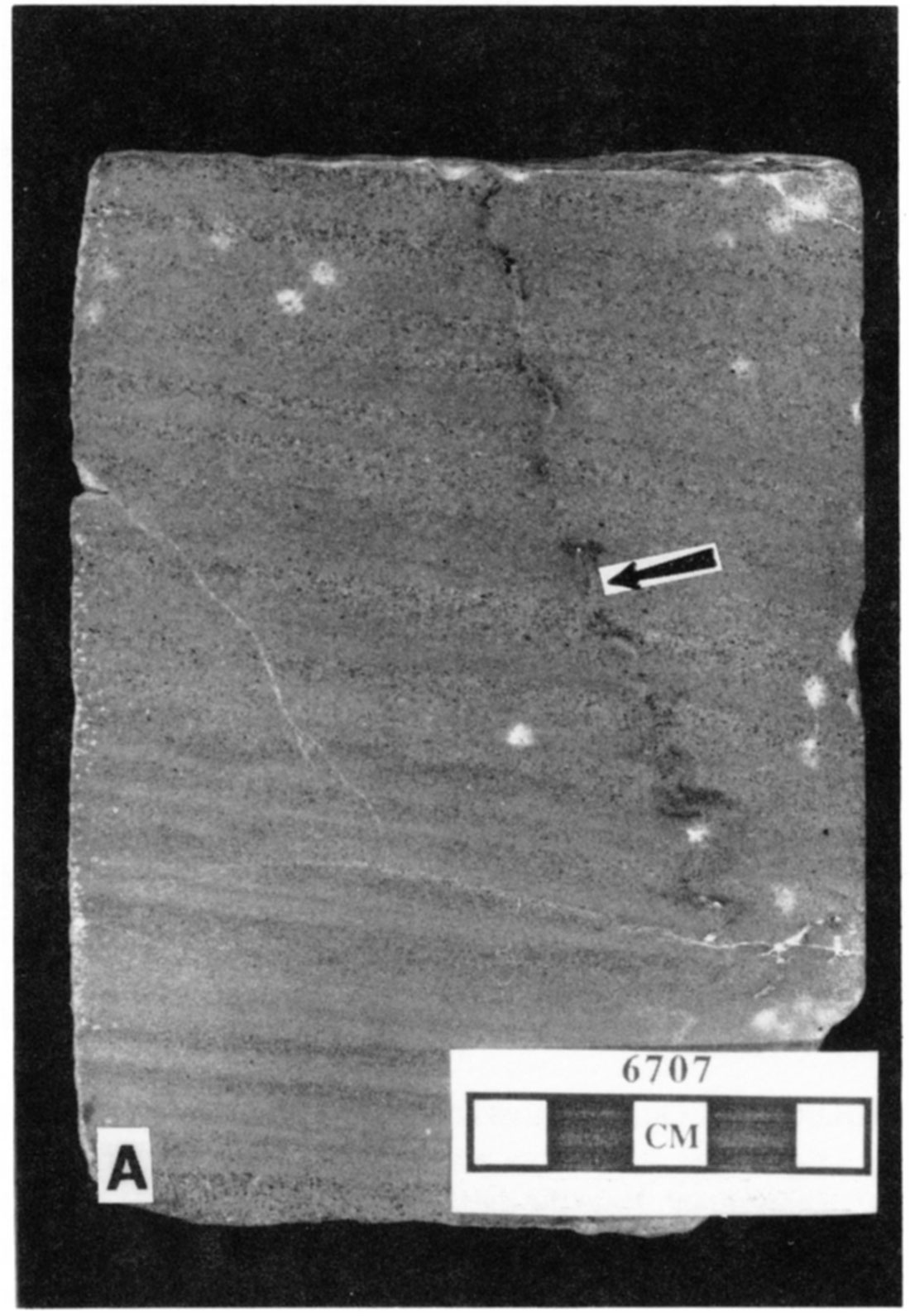
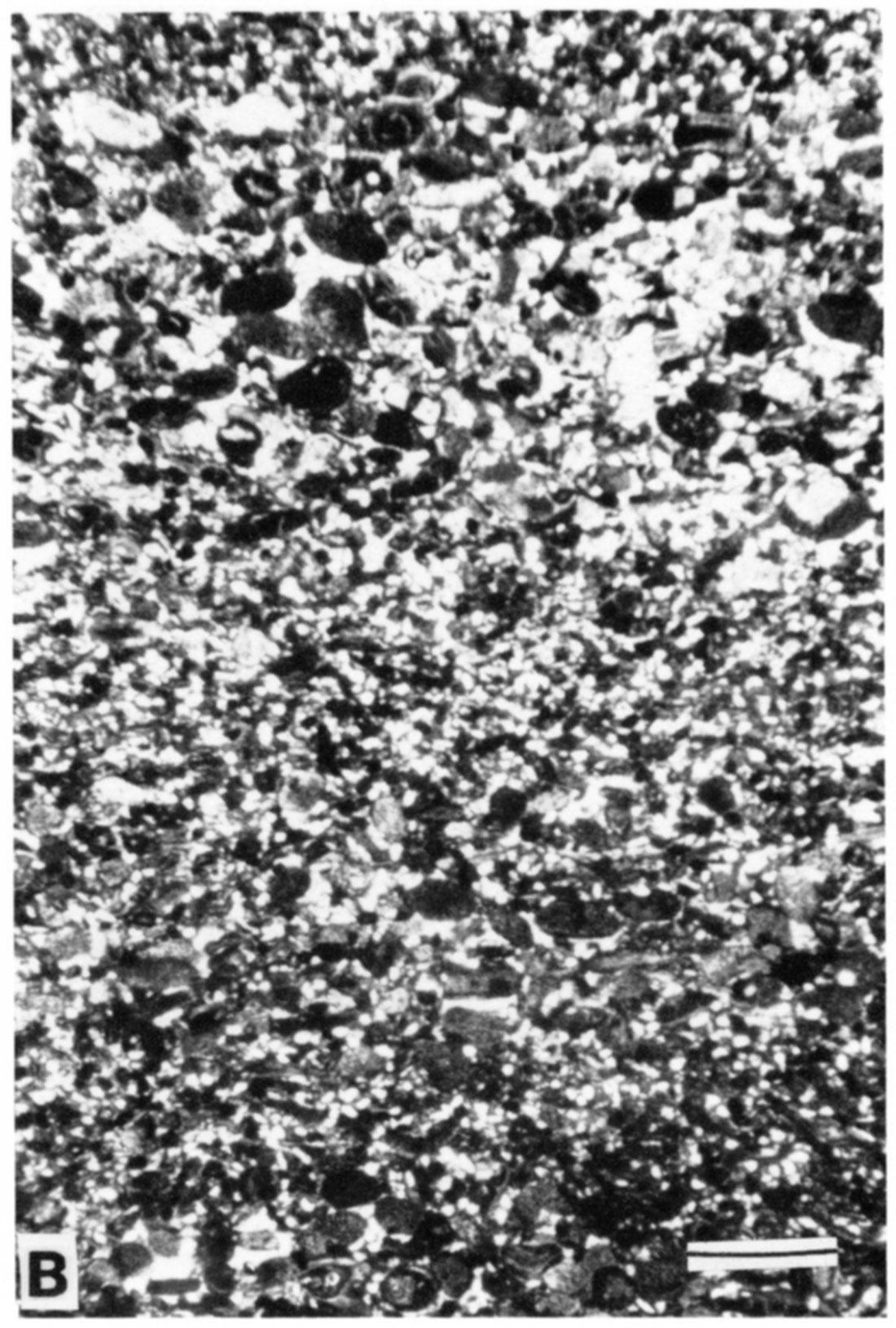
Figure 16—Ste. Genevieve quartzose grainstone from the Mobil #1 Foster displaying three types of fine structure. Climbing translatent strata (1) are 2-5 mm thick and distinctly coarsen upward. Ripple-foreset lamination is developed only in the thicker strata. Grainfall units (2) consist of very fine to fine sand that is only vaguely stratified due to the excellent sorting. Grainflow (3) toes are fining upward to structureless, not as well sorted, and thin downward. The lower surface of the grain flows is concave-upward, possibly reflecting the pre-flow depositional surface. Dip of the grain flows is an apparent dip; true dip is slightly greater than 20°. 6,657-6,658 ft core depth.
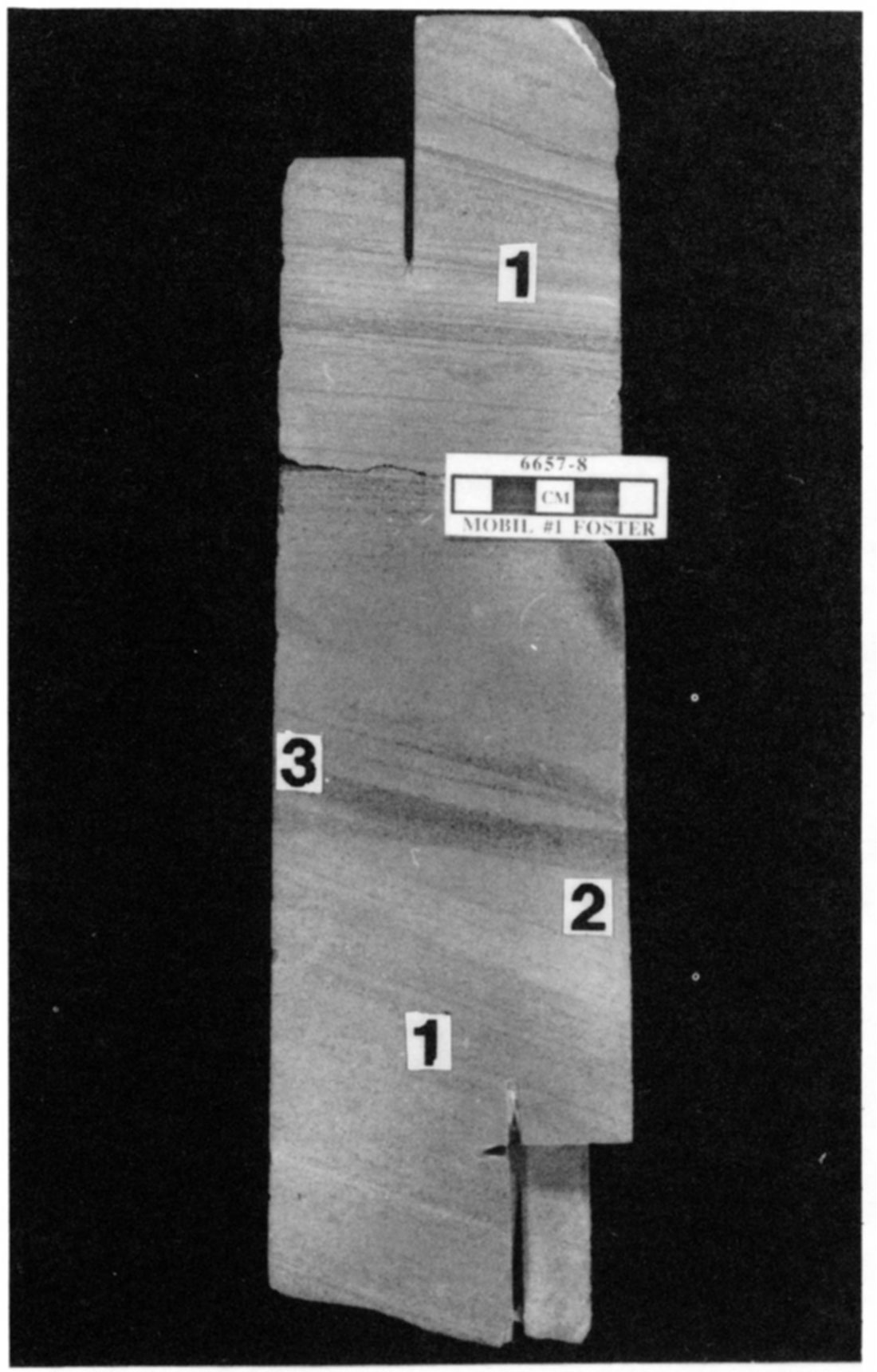
Indistinct Stratification
The second-most abundant type of fine structure is indistinct stratification (fig. 16), that typically dips 10° to 24°. Stratification, commonly highlighted by microstylolites, is difficult to distinguish because most of these deposits are very-well-sorted, very-fine sand, but grains up to medium and are present. Indistinctly stratified units are most abundant in the more steeply dipping, upper portions of cross-strata sets. Best examples of indistinctly stratified intervals in the Mobil #1 Foster are at 6,658.25 and 6,657.6 ft.
Structureless to Fining-upward Units
Units that lack stratification or fine upward are rare (fig. 16). The bottom and top of an individual stratum are commonly sharp. The base is typically slightly irregular; underlying strata are locally truncated at a low angle. Thickness ranges from 2 to 16'mm, and individual units thin by a much as 4 mm across a 3.5-inch (8.9-cm) core. Several of these intervals fine-upward; the base is marked by a thin (< 1 mm thick) medium-sand layer that thickens as the stratum thins. Internal primary sedimentary structures are absent Dips of fining-upward to structureless strata in the Mobil #1 Foster are as high as 24° and always exceed 20°. The best example of fining-upward to structureless strata in the Mobil #1 Foster is at 6,658.2 ft.
Quartzose Grainstone Deposits
Two quartzose grainstone deposits are present in the Mobil #1 Foster core (fig. 6). The lower deposit occurs in the Stevens Member of the St. Louis Limestone and is 3.8 ft (1.2 m) thick (fig. 17). This quartzose grainstone is included in the St. Louis because it is very thin and not easily recognized on logs. The upper deposit marks the base of the Ste. Genevieve Limestone and is 9.4 ft (2.9 m) thick (fig. 18).
Figure 17—Quartzose grainstone from the Stevens Member in the Mobil #1 Foster was deposited as a vegetated eolian sand sheet. Note the dark brown rhizoliths in the two separate calcretes (C). Calcretes are overlain by lithoclast conglomerates containing reworked calcrete clasts (arrow). The strata are almost exclusively climbing translatent strata dipping at angles of less than 7°. Upward-oriented brownish spar (B) precipitated from the base of horizontal sheet cracks (see fig. 20). 6.706-6,710 ft core depth.
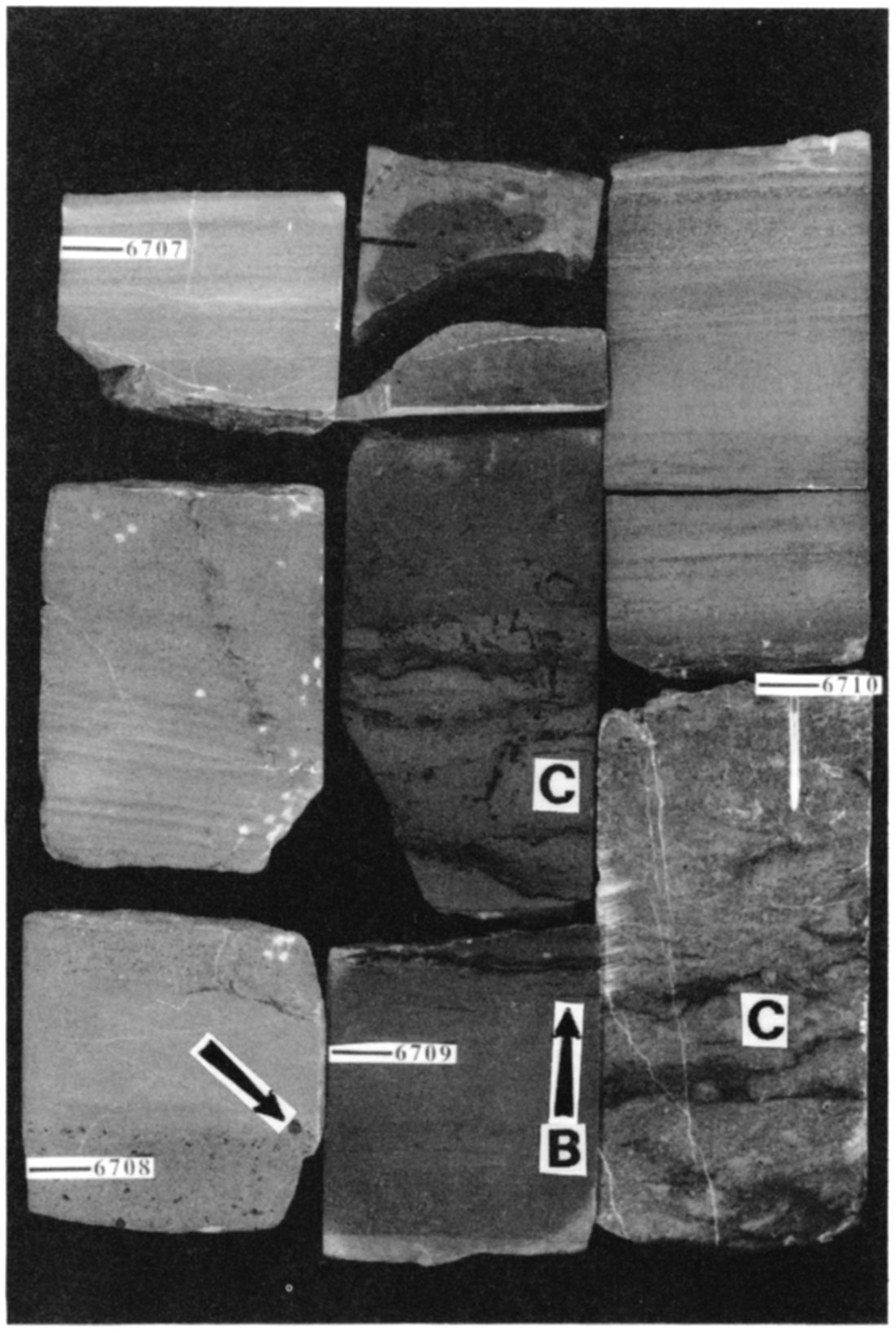
Figure 18—Quartzose grainstone from the Ste. Genevieve in the Mobil #1 Foster. The base of the lithoclast conglomerate (arrow) at 6,661 ft core depth is the St. Louis-Ste. Genevieve boundary. Abundance of cross stratification sets and absence of rhizoliths indicates deposition took place in an active dune field. The majority of stratification is climbing translatent (1), but grainfall (2) and rare grainflow strata (3) also occur. 6,657-6,661 ft core depth.
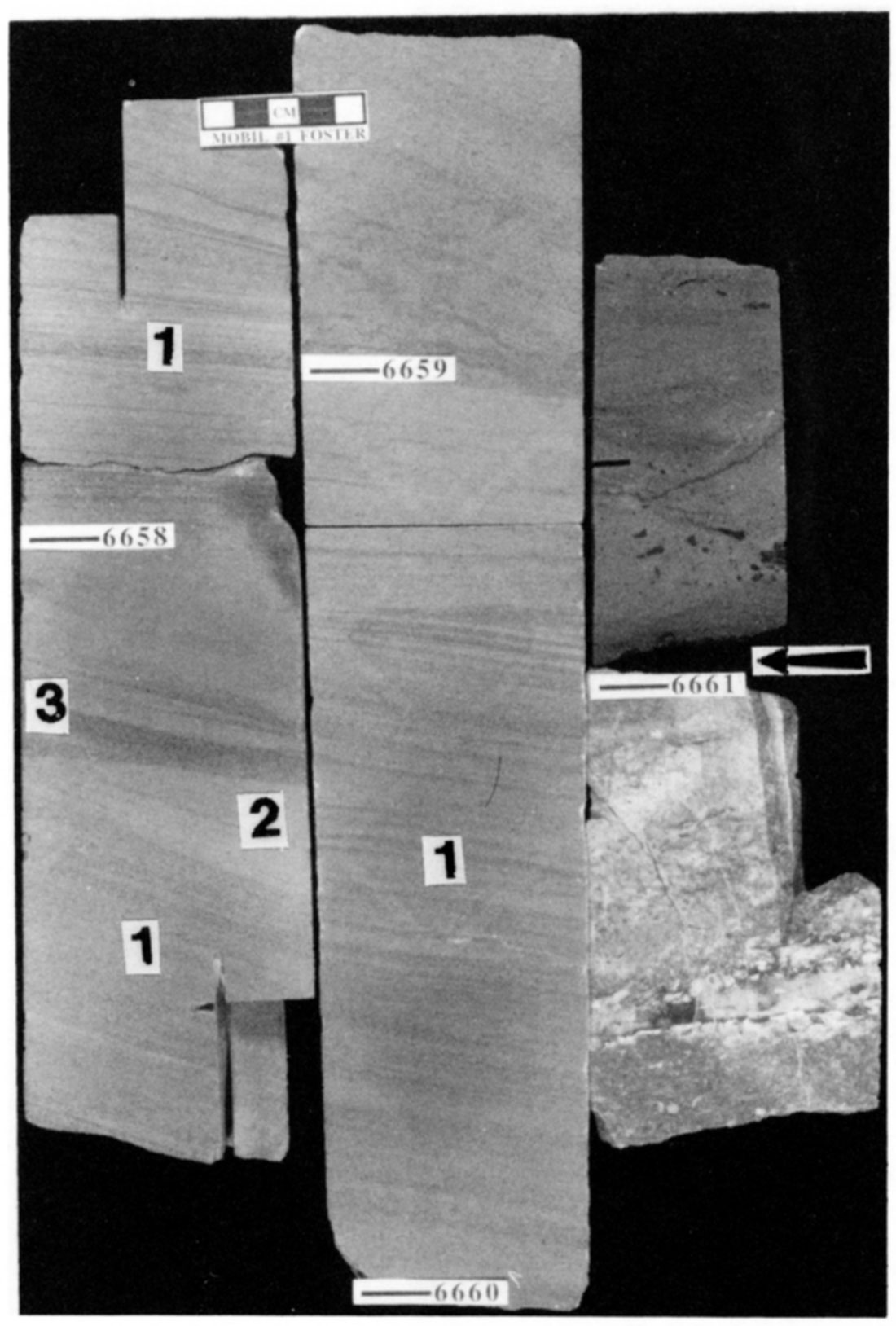
Stevens Member Quartzose Grainstone
The Stevens Member quartzose grainstone deposit contains ubiquitous climbing translatent stratification dipping at less than T. Calcite-cemented tubes coated by indistinctly laminated, dark-brown micrite occur within and directly beneath this quartzose grainstone in the Stevens Member (fig. 17). The majority of these tubes are oriented subhorizontally. Some of these tubes bifurcate downward with smaller diameters in the branches, although this is rare. Rarely the calcite-filled tubes are divided by thin micritic walls (fig. 19). Brownish, bladed, sparry-calcite cement also occurs within some intervals containing calcite-filled tubes. Brownish cement is upward-oriented (astropetal) (figs. 17 and 20) at 6,708.95 ft. This cement nucleates from the base of horizontal sheet cracks as thin semicontinuous layer extending laterally for up to 1.25 in (31 mm). Crystals grew upward into open pore space. Crystal terminations are commonly euhedral and rarely rounded. Compaction of crystal terminations against other grains, however, makes the rounded nature difficult to observe.
Figure 19—Thin micritic walls (arrows) that divide pores are interpreted as alveolar texture in a calcrete in the thin Steves Member eolianite. Mobil #1 Foster, 6,709 ft core depth. Scale bar is 0.5 mm.
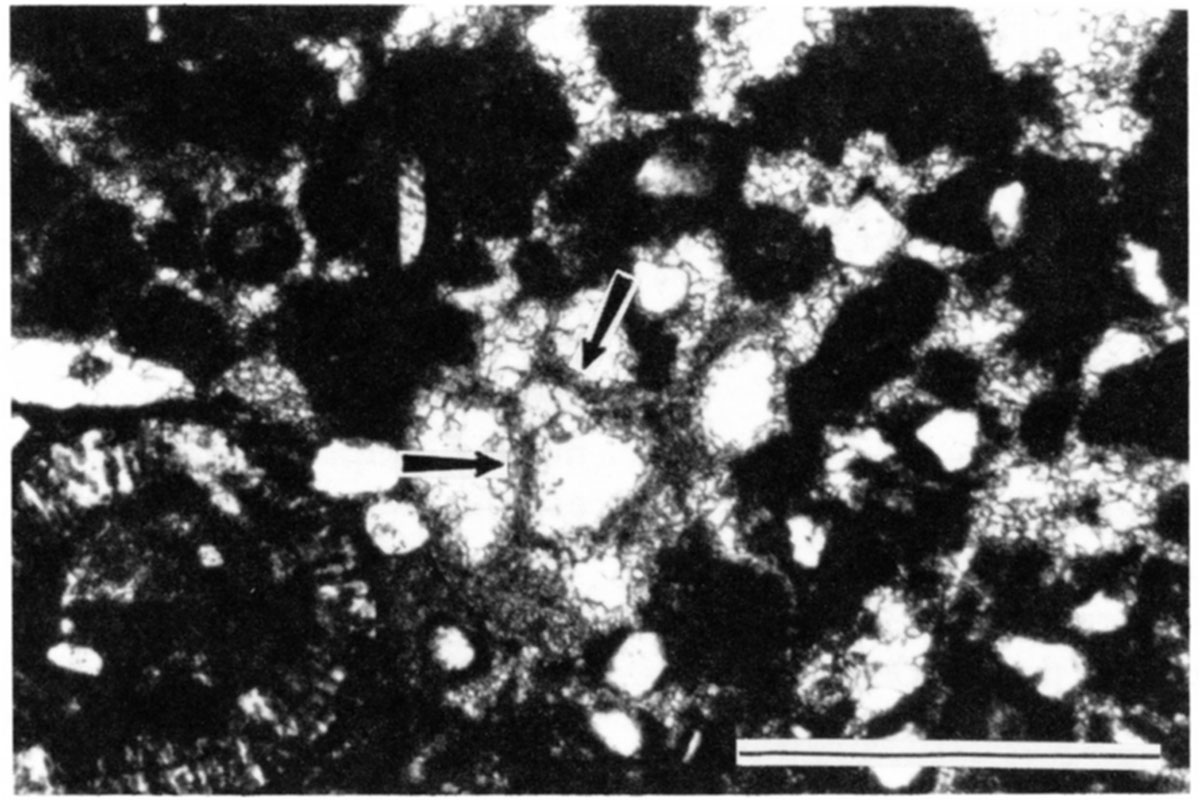
The base of the Stevens Member quartzose grainstone is marked by a lithoclastic conglomerate. Additionally, a conglomerate occurs within this quartzose grainstone (fig. 17). The thickness of these conglomerates range from 0.04 to 0.65 ft (0.01 to 0.2 m). Lithoclasts are up to 0.35 inches (0.9 cm) in size. Conglomerates contain lithoclasts with dark-brown micrite and calcite-filled tubes as described above.
Ste. Genevieve Quartzose Grainstone
The Ste. Genevieve quartzose grainstone contains all three types of fine structure, although structureless to fining-upward units are rare. Sets of cross stratification range from 0.3 to 1.5 ft (0.1 to 0.5 m) thick with dips up to 24°. Calcite-filled tubes and associated structures are absent in the Ste. Genevieve quartzose grainstone. The base of this quartzose grainstone deposit is marked by a lithoclast conglomerate similar to those in the Stevens Member. One lithoclast from the base of the Ste. Genevieve quartzose grainstone contain dark-brown, bladed and micritic pendant cements; geopetal internal sediment in a brachiopod within the clast indicate. these were not upward-oriented cements (fig. 21). The basal Ste. Genevieve quartzose grainstone contains these brown lithoclasts, although the parent lithology is absent in the immediately underlying strata.
Figure 20—Upward-oriented brownish calcite cement formed along sheet cracks immediately below a calcrete (see fig. 17) in the Stevens Member eolianite. Possible rounded terminations, upward orientation, and proximity to a calcrete suggest cements may have precipitated in the capillary fringe (cf. Goldstein, 1988). Mobil #1 Foster, 6,709.0 ft core depth. Scale bar is 0.5 mm.
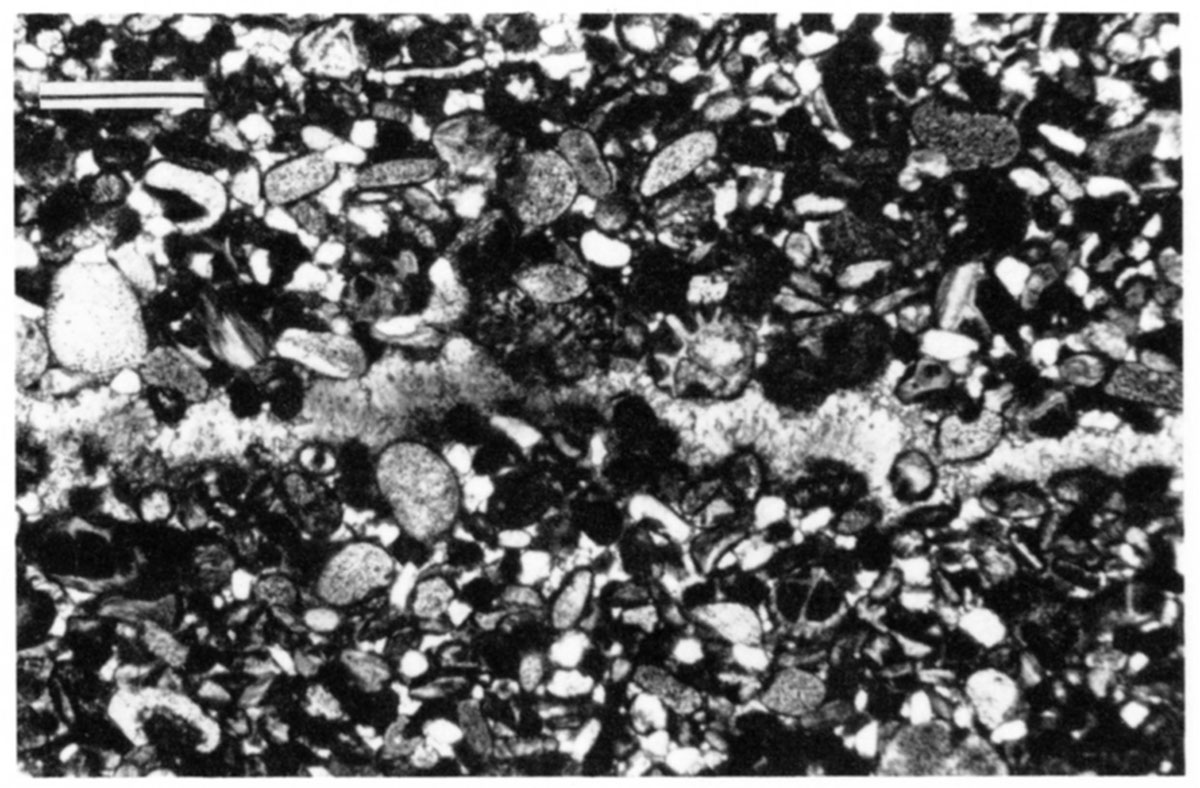
Figure 21—Brownish micritic and sparry calcite cement in a lithoclast at the base of the Ste. Genevieve eolianite in the Mobil #1 Foster. Rounded crystal terminations and geopetal sediment inside the brachiopod indicate the cement is a pendant cement formed in the meteoric vadose zone. 6,660.25 ft core depth. Scale bar is 0.5 mm.
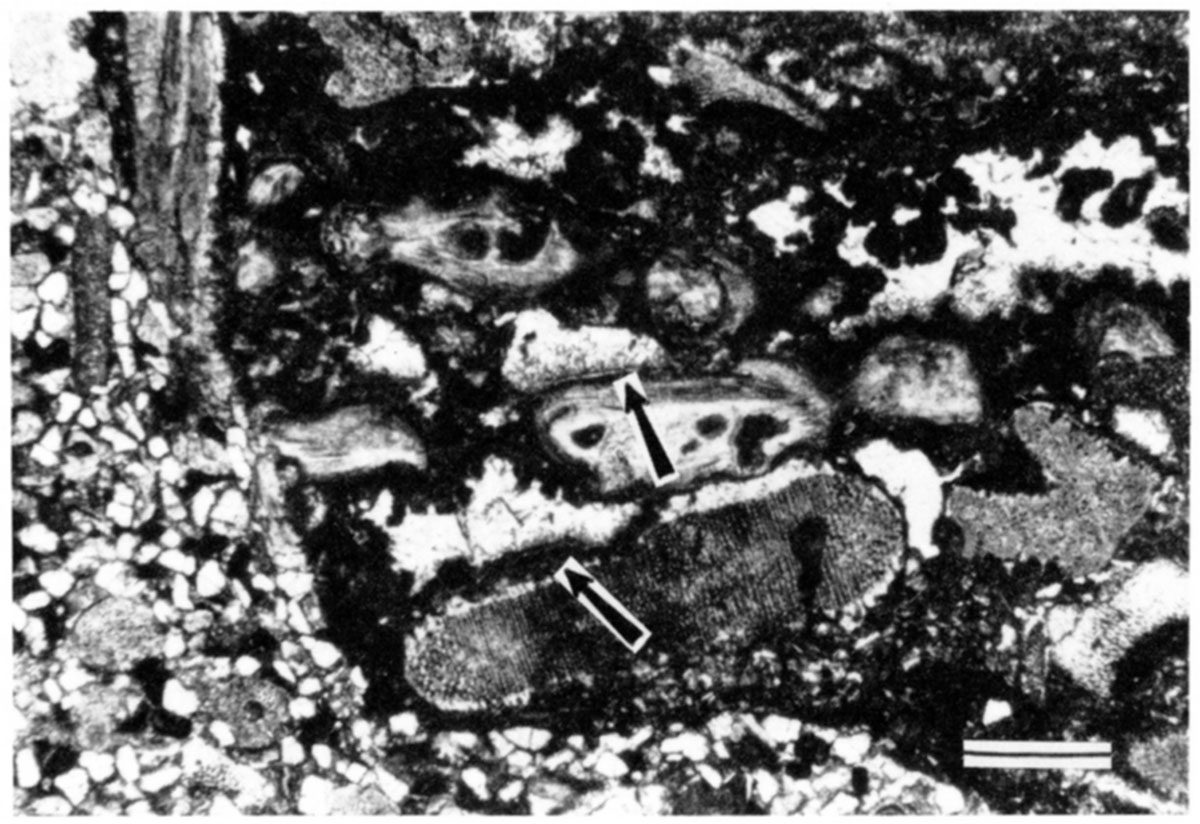
Interpretation
Based on multiple lines of evidence (table 2), quartzose grainstone in the Mobil #1 Foster core is interpreted a carbonate eolianites. Climbing translatent strata are generally considered diagnostic of eolian sedimentation (Hunter, 1977, 1981; Kocurek and Dott, 1981; Kocurek, 1991). Most other criteria indicative of an eolian interpretation are equivocal in isolation. Therefore, multiple lines of evidence are commonly required to affirm a wind-blown origin for carbonate grainstones.
Hunter (1989) ascribed a similar facies from the Illinois basin in southern Indiana to eolian origin. Handford (1990) and Handford and Francka (1991) interpreted the quartzose grainstone in the Damme field (Finney County) and the Big Bow Field (Stanton and Grant counties), Kansas. as eolian in origin. Handford and Francka (1991) recognized climbing translarent, grainfall, and grainflow stratification from core in the Big Bow field in Stanton and Grant counties, Kansas.
Table 2—Contrasting features of eolian and subaqueous grainstones (based largely on Hunter, 1981, 1989). Boldface indicates features present in quartzose grainstones in the Mobil #1 Foster. Also refer to figs. 15-21.
| Eolian | Subaqueous |
|---|---|
| Climbing translatent stratification Grainfall Grainflow Well to very well sorted Typically very fine to medium sand, grains >4 mm extremely rare Well-rounded and abraded allochems Frosted quartz grains Absence of shale/micrite, and mica present (except in interdunes) Large-scale (> 1 m) cross strata Planar to wedge-planar cross strata Tangential foresets Straight-crested, low-amplitude ripples (high ripple indices) (cf. fig. 22) Trace fossils absent to very rare Adhesion ripples Calcrete (scattered rhizoliths, alveolar texture, etc.) Vadose cements (scattered pendant, upward-oriented, and meniscus) |
Subaqueous climbing ripples Grainfall Grainflow Moderate sorting Grains >4 mm common Rounding variable Frosted grains absent Mud or clay/micrite, and mica Large-scale cross strata rare Wedge-planar less common Tangential foresets less common Sinuous, high-amplitude ripples (low ripple indices) (cf. fig. 22) Trace fossils present Adhesion ripples absent Calcrete present only at exposure surfaces Vadose cements present only at exposure surfaces |
Climbing Translatent Stratification
Climbing trans latent stratification is considered the product of migration of wind ripples. Climbing wind ripples are distinct in form and appearance from climbing subaqueous ripples (fig. 22). Each millimeter-scale, coarsening-upward stratum forms from the migration of a single, climbing wind ripple. The coarsest grains are concentrated along ripple crests while finer grains are protected in the ripple trough (Hunter, 1977; Fryberger and Schenk, 1988). In the ripple troughs, very fine sand and very coarse silt are protected from incoming saltating grains and from direct airflow across the ripple crests (Fryberger and Schenk, 1988). The thin layers of very fine sand and very coarse silt that are deposited in ripple troughs are typically less than 1 mm thick and produce a feature termed pin-stripe lamination (Fryberger and Schenk, 1988). Ripple-foreset laminae are not well developed in eolian climbing translatent strata due to an absence of avalanching on the gently sloping lee sides of wind ripples.
Climbing trans latent strata are as thick as 9 mm (fig. 15). This unusual thickness might reflect damp conditions that would make the grains more cohesive, thus reducing the amount of the wind-ripple that is destroyed prior to its burial by the succeeding ripple train. According to Fryberger and Schenk (1981), increases in the rate of deposition and the rate of ripple-migration also can account for unusually thick climbing translatent strata.
Figure 22—Features of eolian and subaqueous climbing ripples. Wind ripples (A) have low amplitudes and relatively long wavelengths with the coarser grains concentrated at the ripple crest. Low-angle foresets retard avalanching on lee sides of ripples. These features produce climbing trans latent strata that are characteristically thin, of uniform thickness, commonly inversely graded, and contain few visible ripple-foreset laminae. In contrast, subaqueous ripples (B) have higher amplitudes with the coarser grains relegated to the ripple troughs. Avalanching is common on the steep lee sides of the ripples. These features produce climbing translatent strata that are typically thicker, normally graded, and contain well-developed ripple-foreset laminae (modified from Kocurek and Dott, 1981, their fig. 3)
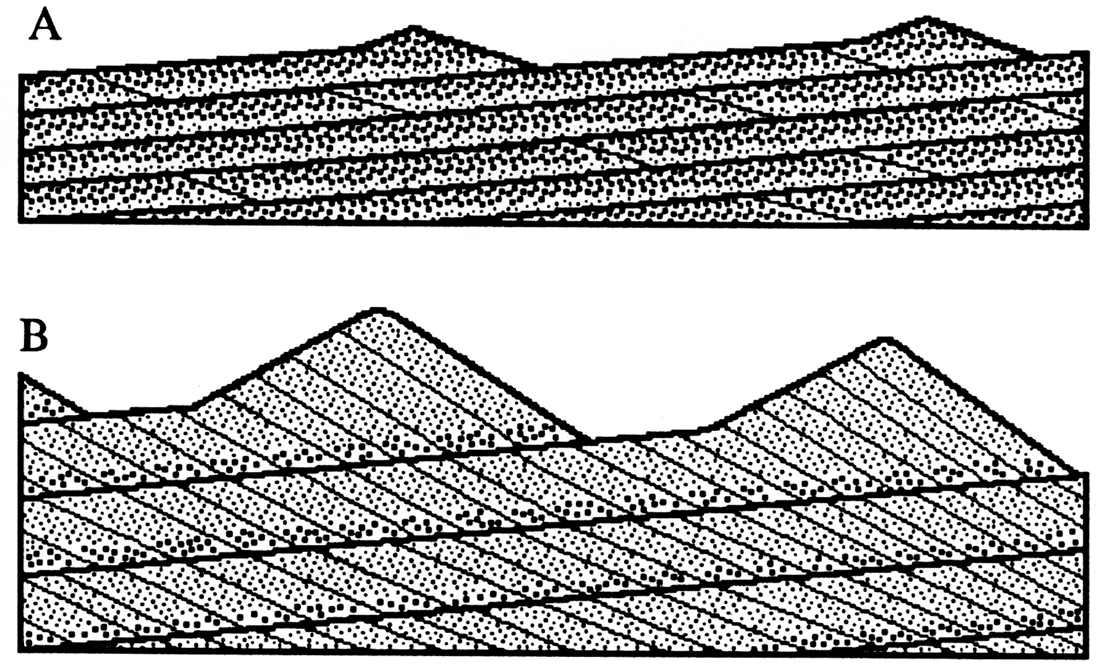
Grainfall Strata
Indistinctly stratified units in quartzose grainstones are interpreted to have formed by grainfall in the flow separation on the lee side of dunes. Indistinct stratification is the result of excellent sorting of grains. Fine to very fine grains overrun the crest and are deposited on the lower slipface or apron a grainfall strata. Grainfall strata are distinguished from climbing translatent strata because wind-ripple stratification exhibits a coarsening-upward grain distribution, ripple-foreset laminae, and generally have lower dips, although some overlap exists.
Grainflow Strata
Structureless to fining-upward units are interpreted as grain flow deposits. Medium-sand grains that concentrate at the slipface crest subsequently avalanche, pick up finer grains by eroding underlying strata, and are deposited as grainflows. Structureless to fining-upward units are extremely rare in the quartzose grainstone facies. As other evidence suggests dunes were present. Either the upper parts of dunes were truncated by interdune erosion or avalanching on slipfaces was rare. Structureless to fining-upward deposits are intercalated with indistinctly stratified grainfall deposits and climbing translatent strata, as is common in small eolian dunes (Kocurek and Dott, 1981). Slipfaces in modern dunes commonly dip 33° to 34°, grain flows in the Mobil #1 Foster never exceed 24°. Dips angles of approximately 20° to 24° are consistent with grainflow deposition at the angle of repose and subsequent flattening through 35% compaction (cf. Rittenhouse, 1972). Compactional features are common and include stylolites and interpenetrating grain contacts. Erosion of steeper upper parts of slipfaces could also explain the low dips, as well as the scarcity of grainflow deposits (cf. McKee, 1979).
Basal contacts of grainflow deposits sometimes truncate underlying strata indicating scour. Thinning of as much as 4 mm across a 8.9-cm (3.5-in) core is observed, and is interpreted as wedging at the toe of a grainflow. The concaveupward nature of these units has been recognized at the toe of modern grain flows, possibly indicating the preflow depositional surface (cf. Hunter, 1977). Grainflows commonly coarsen upward because of dispersive pressures during flow (Bagnold, 1954; Hunter, 1977; Kocurek and Don, 1981; Kocurek, 1991). Grain-size distribution, however, depends on the location in a grainflow. Upward coarsening is common in proximal parts of grainflows (Fryberger and Schenk, 1981; Ahlbrandt and Fryberger, 1982). The mantle of coarser grains outruns the finer grains to the lower part of the grainflow and are later buried by finer-grained material, creating a fining-upward unit (Ahlbrandt and Fryberger, 1982).
Eolian Sub-environments
The Stevens Member and Ste. Genevieve quartzose grainstones in the Mobil #1 Foster core represent different environments of eolian accumulation. Low-angle-stratified deposits of the Stevens Member are formed as vegetated sand sheets. Cross stratified deposits of the Ste. Genevieve indicate dune fields. These successions illustrate two different styles of eolian sedimentation in these units over much of southwestern Kansas (figs. 15, 16, 17, and 18).
Vegetated Sand Sheet
The quartzose grainstone in the Stevens Member of the St. Louis is composed entirely of subcritically climbing translatent strata with dips less than 7° (figs. 15 and 17). The numerous calcite-filled tubes coated by indistinctly laminated (fig. 17), dark-brown micrite near the top of the underlying shoaling-upward succession are interpreted as rhizoliths with calcite-filled root casts and dark-brown rhizocretions (cf. Klappa, 1980). The ubiquitous climbing translatent strata and numerous rhizoliths indicate that the upper St. Louis eolianite was a vegetated sand sheet. The thin micritic bridges (fig. 19) associated with the rhizoliths are excellent examples of alveolar texture (cf. Esteban and Klappa, 1983). Upward-oriented (astropetal), bladed, brownish, parry-calcite cement (fig. 20) is very similar to ribbon spar described from the Pennsylvanian Holder Formation in New Mexico (Goldstein, 1988). Goldstein reasoned that these cements precipitated in the capillary fringe at the base of the vadose zone. A similar origin for the brownish cements in the eolianites is likely, based on the preferred upward orientation. Possible rounded terminations of crystals may reflect a meniscus air-water contact.
Sand sheets are regions of predominantly eolian sedimentation where dunes with slipfaces are lacking (Kocurek, 1986; Kocurek and Nielson, 1986). Sand sheets commonly occur along the margins of dune fields (Kocurek, 1986). Conditions inhibiting the formation of dunes and favoring sand-sheet development are discussed in Abegg (1992). Handford and Francka (1991) recognized sand-sheet deposits from the Big Bow field in Stanton and Grant counties, but did not describe them.
Dune Field
The Ste. Genevieve eolianite contains higher-angle cross stratification in sets up to 1.5 ft (0.5 m) thick (figs. 16 and 18). Rhizoliths are absent. This indicates deposition in an unvegetated, active dune field. Cross strata sets are typically dominated by climbing translatent stratification, but the upper parts of the thickest sets contain grainfall and, rarely, grainflow stratification. The majority of cross strata dip Ie than 20', suggesting that only dune aprons are commonly preserved. Compactional flattening could also help explain the low dip angles (cf. Rittenhouse, 1972). Thickness of eolian grainflows is proportional to slipface height (Hunter, 1977). Based on a plot of maximum thickness of eolian grain flow versus slipface height (Kocurek and Dotr, 1981), the thickest eolian grainflow observed, 1.6 cm, correspond to a slipface 0.9 m high. This is consistent with the maximum observed cross strata thickness, 0.8 m, from cores in southwestern Kansas. Interdune deposits are not recognized.
The base of each quartzose grainstone interval is marked by a lithoclast conglomerate (figs. 17 and 18). Dark-brown lithoclasts are reworked from the underlying paleosol. These conglomerates were formed in part by erosion of the underlying skeletal limestones and calcretes. The Ste. Genevieve eolian unit is not underlain by a calcrete, yet the basal lag contains calcrete lithoclasts. Either the calcrete was removed by erosion or the calcrete clasts were transported from nearby.
Lateral Variability
Vertical successions of lithologies similar within the St. Louis and Ste. Genevieve Limestones occur over much of the Hugoton embayment. Log cross sections, calibrated by cores, permit characterization of lateral variability in facies and composition across southwestern Kansas.
Anhydrite, characteristic of the Hugoton Member of the St. Louis Limestone, is preserved in portions of Morton, Stanton, Stevens, Grant, Seward, Haskell, Hamilton, Kearny, and possibly Meade counties, southwestern Kansas (figs. 23 and 24). Many anhydrite units are laterally correlative over several counties, but some are discontinuous (figs. 10 and 24). Anhydrite is thin in southern Stevens County and is absent in southern Morton, southwestern Stevens, and southern Seward counties (fig. 24). To the north and east, recognition of characteristic anhydrite and slightly argillaceous dolomitic carbonate on wireline logs is difficult because of brecciation (figs. 10, 23, and 24).
Figure 23—East-west stratigraphic cross section of Hugoton Member anhydrite. Many anhydrite beds are laterally correlative.
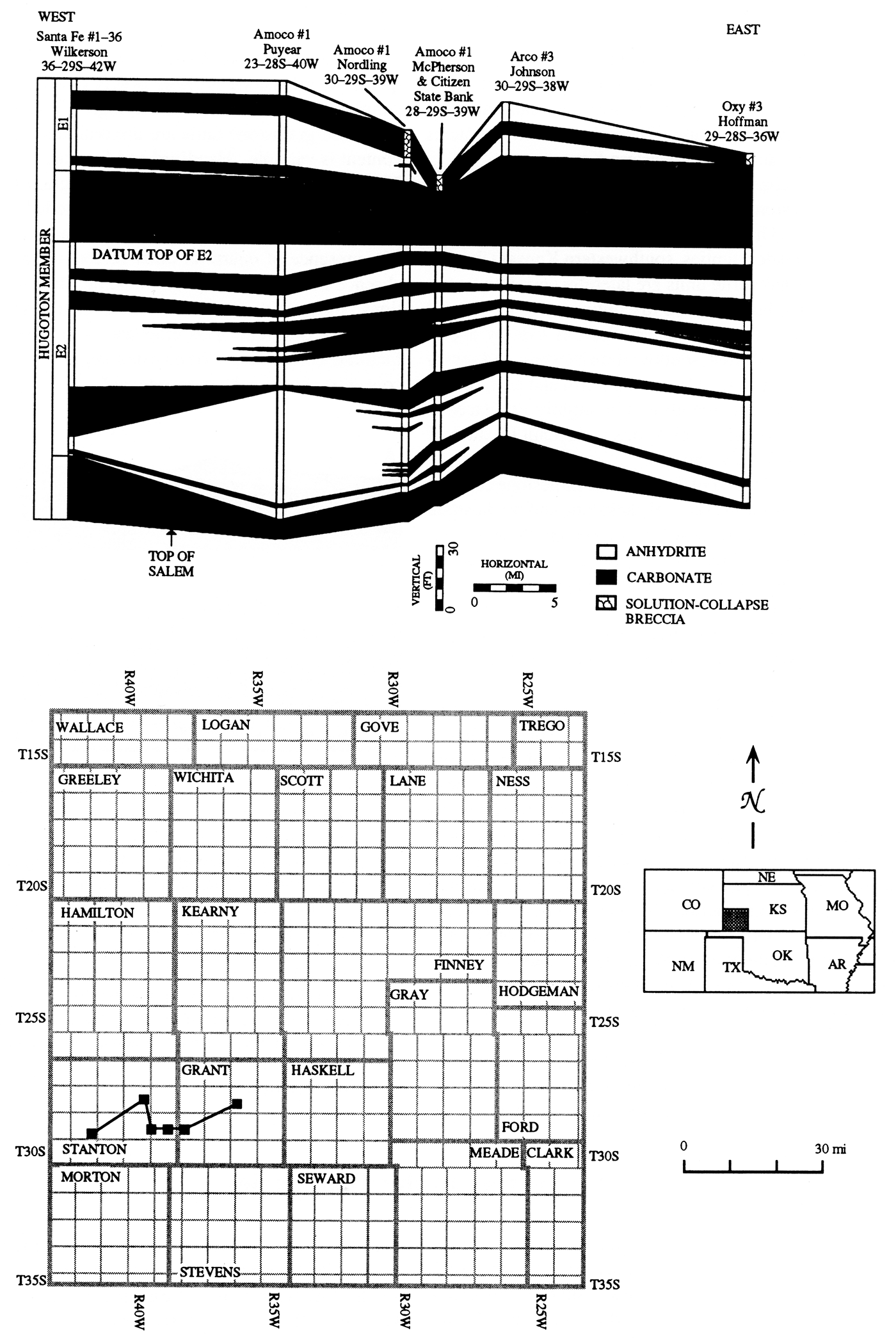
Figure 24—Location of preserved anhydrite in southwestern Kansas. To the north and east, evaporites were dissolved forming solution-collapse breccia. Anhydrite is thin to absent to the south in southern Morton and Stevens counties, suggesting increasing marine influence toward the Anadarko basin. Dashed lines indicate areas where well control is sparse or absent. Updip limit of St. Louis from Thompson and Goebel (1968, their fig. 3).
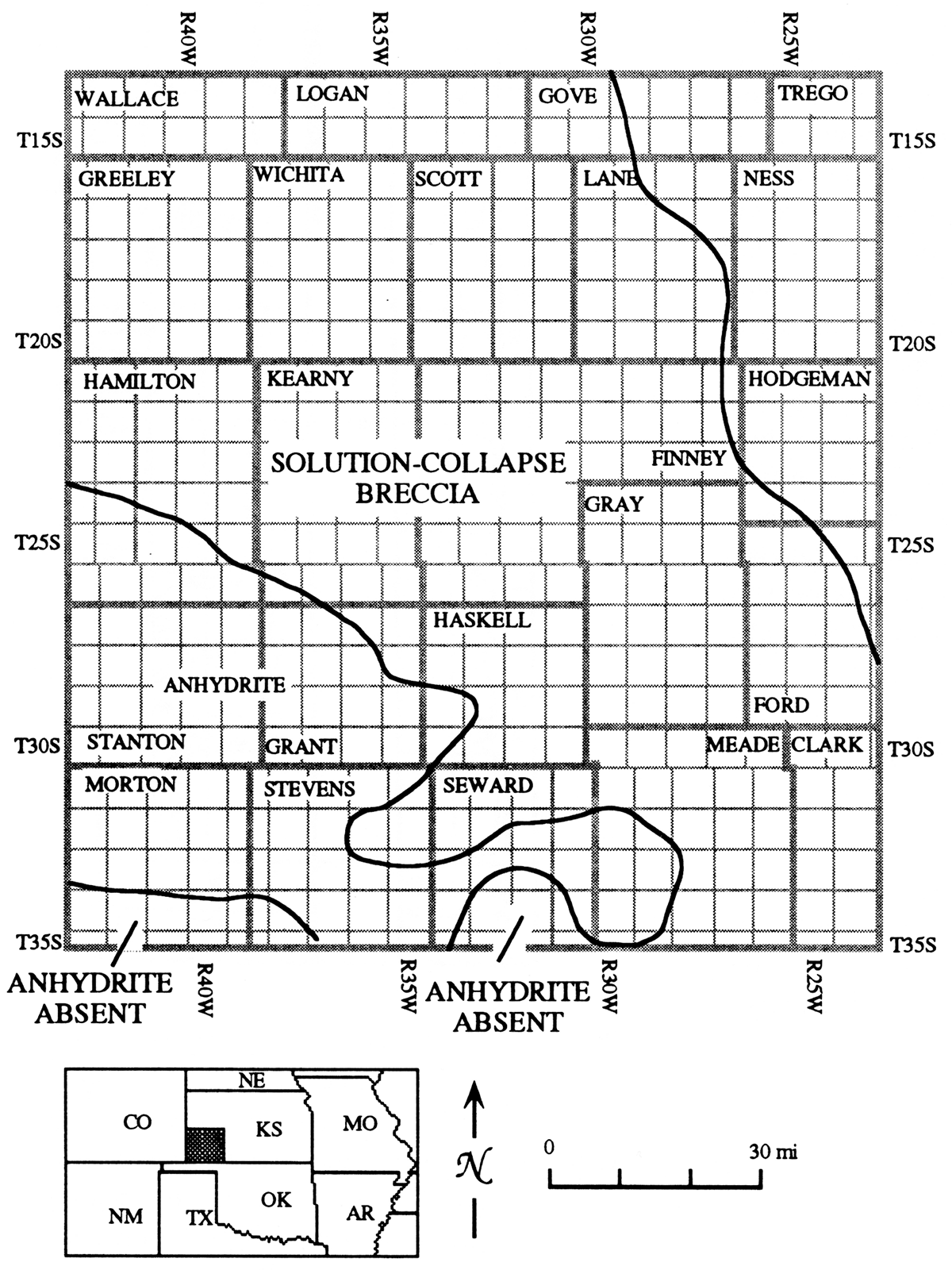
The Stevens Member of the St. Louis Limestone consists largely of normal-marine skeletal packstone and wackestone in southwestern Kansas. Ooid grainstones are thickest near the top of the Stevens Member. A thin quartzose grainstone is interstratified with oolitic grainstone and packstone in the Stevens Member (fig. 6). This unit is very close to the base of the Ste. Genevieve Limestone in most cores, but in Stevens County it is separated by a thicker section of subtidal strata (Abegg, 1992).
Porous oolitic grainstones occur in many areas, but no regional trend has been recognized. Based on the location of oolite reservoirs, Handford (1988) concluded that oolite bodies are oriented northwest-southeast. Because these fields roughly parallel the Central Kansas uplift, Handford reasoned oolites developed parallel to depositional strike and are similar to Bahamian marine sand belts (Ball, 1967). However, local structure and diagenesis may also contribute to oolite reservoir distribution. Moreover, Youle (1990, his fig. 1) indicates a northeast-southwest orientation of Stevens Member oolites in the Wendel Pool in Gray County, Kansas. Additional work is needed to determine the controls on distribution of porous ooid grainstones in the Stevens Member of the St. Louis Limestone.
Quartzose grainstones interbedded with peloidal, oolitic, or skeletal carbonates comprise the Ste. Genevieve Limestone. As many as four quartzose grainstone units are recognized in the Ste. Genevieve in core. In some wells, quartzose grainstone is either poorly developed, absent, or simply not recognizable in the logs. This suggests that quartzose grainstone units are discontinuous or that quartz content is variable. Handford and Francka (1991, their fig. 11) illustrate quartz-poor and quartzose grainstones. Minor detrital quartz occurs in many interbedded peloidal and skeletal carbonates; some contain as much as 40% quartz. The presence of quartz in other facies, combined with the absence of significant quartz in some Ste. Genevieve sections, makes tracing of individual quartzose grainstones extremely difficult. This emphasizes the need for core to facilitate correlation. No consistent regional trends in quartz concentration have been recognized.
Lithostratigraphic Boundaries
In order to facilitate consistent identification of Upper Mississippian lithostratigraphic boundaries, criteria for such picks need to be standardized. Facies changes make identification of Upper Mississippian units difficult locally. Facies changes are hard to recognize unless core or cuttings are utilized. Abegg (1992) used 13 cores covering much of the southern Hugoton embayment to calibrate log response to facies. This section discusses lithostratigraphic boundaries for the following units: 1) Salem Limestone, 2) Hugoton Member of the St. Louis Limestone, 3) Stevens Member of the St. Louis Limestone, 4) Ste. Genevieve Limestone, and 5) Shore Airport Formation (fig. 2).
Salem-St. Louis Boundary
This boundary is absent in the Mobil #1 Foster. In other cores, the Salem-St. Louis boundary is marked by a change from ooid-skeletal grainstones of the Salem Limestone to algal boundstone and breccia of the Hugoton Member of the St. Louis (Abegg, 1992). On wireline logs, the exact placement of the boundary is difficult as both units are typically dolomitic. It is commonly possible to recognize a change from clean, porous dolomitic limestone of the upper Salem to slightly more argillaceous, dolomitic carbonate intercalated with anhydrite in the Hugoton (fig. 25). Cored breccias in the Hugoton Member consist of dolomitic carbonates that are typically less porous than the underlying Salem. Breccias can also be differentiated from the Salem Limestone using the gamma-ray log; cross stratified upper Salem grainstones are typically clean, whereas low-energy, dolomitic carbonates and breccias of the Hugoton Member are typically somewhat shaly (fig. 26).
Figure 25—Typical gamma-ray and neutron-density log for upper Mississippian strata from the Amoco #1 Puyear (sec. 23, T. 28 S., R. 40 W.). Note the extremely low gamma ray values and negative density readings for anhydrite beds (E1 and E2). See text for explanation. Compare with fig. 26.

Figure 26—Gamma-ray and neutron-density logs from the Flynn #31-1 Shaw (sec. 31, T. 31 S., R. 34 W.). Note the fairly low gamma-ray values and numerous minor shale kicks of the breccia and the corresponding lower density readings relative to neutron readings. These log signatures are calibrated to the cored breccias in the Amoco #3 Wilson A (sec. 30, T. 30 S., R. 33 W.) approximately 9 miles (14.4 km) to the northeast.

Hugoton Member-Stevens Member Boundary
In the Mobil #1 Foster and elsewhere in southwestern Kansas, the boundary of the Hugoton and Stevens Members of the St. Louis Limestone is placed at the change from dolomitic carbonate and anhydrite to skeletal packstone/wackestone (figs. 25 and 26). This facies transition is commonly marked by a thin (≤ 3 ft) skeletal-ooid grainstone to packstone. Typical logs of the Hugoton Member indicate lower neutron porosity than density porosity, indicating dolomitic carbonates (figs. 25 and 26). Interbedded anhydrites have very low gamma-ray values and negative density porosities (fig. 25). In the Stevens Member the density and neutron curves are nearly coincident, indicating relatively pure limestones (figs. 25 and 26).
St. Louis-Ste. Genevieve Boundary
In southwestern Kansas, previous authors place oolitic limestones in the St. Louis Limestone (e.g., Clair, 1948, 1949; Thompson and Goebel, 1963, 1968). In the Illinois basin, however, the base of the Ste. Genevieve Limestone is generally placed at the stratigraphically lowest prominent oolitic (Atherton et al., 1975) and/or arenaceous limestone (Thompson, 1986). In order to be consistent with the original definition in the type area, a similar boundary could be adopted in the Hugoton embayment. However, several considerations argue against such a boundary.
The base of the stratigraphically lowest prominent oolite is difficult to pick without core or cuttings. Although many of the ooid grainstones are porous, intergranular porosity is occluded in many others by a combination of compaction and cementation, as in the Mobil #1 Foster (fig. 3). In wells without porous carbonates, this formation boundary would not be easily determined from wireline logs. Additionally, including oolites in the St. Louis Limestone in the Hugoton embayment is so entrenched by usage in industry and the literature that it is best not to change unless a more practical boundary can be determined.
In the Mobil #1 Foster and elsewhere in southwestern Kansas, the base of the Ste. Genevieve is herein placed at the stratigraphically lowest prominent quartzose grainstone. in order of decreasing reliability, the four most dependable ways to pick the St. Louis-Ste. Genevieve boundary in wireline logs include: 1) at the change from coincident neutron and density logs to a log crossover with lower neutron than density porosity, 2) at an uphole negative shift in the photoelectric (Pe) curve, 3) at an uphole positive shift in the interval transit time on sonic logs, and 4) at the top of the highest porous ooid grainstone. In many areas, the quartzose Ste. Genevieve Limestone is marked by a prominent crossover of the neutron and density log patterns, both calibrated for limestone (figs. 25 and 26) and also by shifts in the Pe and sonic logs. Where quartzose facies are absent or poorly developed, the Ste. Genevieve-St. Louis boundary can be placed at the base of a small positive gamma-ray shift immediately above the uppermost porous, presumably oolitic, limestone.
Ste. Genevieve-Shore Airport Boundary
The boundary between the Ste. Genevieve Limestone and the Shore Airport is one of the most consistent picks in the Mississippian section because of the increased argillaceous component in the Shore Airport Formation. This boundary is not present in the Mobil #1 Foster core. This boundary should be placed where neutron porosity lower than density porosity in the quartzose Ste. Genevieve changes to neutron porosity greater than lower density porosity in the argillaceous carbonates of the Shore Airport (figs. 3, 25, and 26). This boundary typically corresponds to the base of a shale observable on the gamma ray log. Locally, however, the basal Shore Airport is a sandstone and conglomerate (Clair, 1948, 1949; Veroda, 1959; Fugitt and Wilkinson, 1959). In this case, the Shore Airport neutron-density logs are similar to those of the Ste. Genevieve, but the sandstone typically has higher porosity than the tight quartzose grainstone (e.g., Southland #1-19 Hampton, sec. 19, T. 34 S., R. 34 W.). In sonic logs, the top of the Ste. Genevieve is marked by low velocity of the first prominent shale bed (fig. 3).
Mississippian-Pennsylvanian Boundary
The Mississippian-Pennsylvanian boundary in southwestern Kansas is a highly erosional disconformity (e.g., Thompson and Goebel, 1968). The Shore Airport in the Mobil #1 Foster is overlain by the Kearny Formation (Morrowan) (cf. Swanson, 1978, his fig. 5). To the north and east, however, the Upper Mississippian is overlain by the "Gray group" (cf. Youle, 1991) and the Cherokee Group (Desmoinesian) (Goebel and Stewart, 1979).
The Kearny Formation consists of interbedded shales, sandstones, and carbonates (McManus, 1959; Swanson, 1978). The lower Kearny consists of shales interbedded with dolomitic calcareous sandstones and dolomitic arenaceous carbonates (McManus, 1959). Reworked Mississippian lithoclasts are common at the base of the Pennsylvanian. These conglomerates are interpreted as a transgressive lag that formed as the seas flooded the previously subaerially exposed shelf (cf. Youle, 1991). Log signatures of dolomitic sandstones and carbonates typically have low gamma-ray values and higher density porosity than neutron porosity (figs. 25 and 26).
The contact of the Kearny and Shore Airport Formations is locally difficult to place. Character of this boundary is variable because of the highly erosional unconformity that separates Mississippian and Pennsylvanian strata. Additionally, lower Kearny sandstones and carbonates are locally difficult to resolve from argillaceous limestones of the Shore Airport (McManus, 1959). The Kearny commonly contains significantly more shale and sandstone than the underlying Shore Airport.
In the eastern and northern Hugoton embayment, the Shore Airport is directly overlain by carbonates and thin shales of the Atokan? "Gray group"(Youle, 1991) (e.g., Pendleton #1 Schauf, sec. 16, T. 27 S., R. 29 W., Gray County) or the siliciclastic-dominated Desmoinesian CherokeeGroup (e.g., Alma #1 Watchorn, sec. 13,T.15S.,R.33 W., Logan County). "Gray group" carbonates are commonly less argillaceous and the shales are more radioactive than are the limestones and shales of the underlying Shore Airport. This produces more contrast in "Gray group" gamma-ray log signatures relative to the Shore Airport. In cases where the Shore Airport has been eroded (fig. 4), the Ste. Genevieve or the St. Louis are directly overlain by Morrowan, Atokan, or Desmoinesian strata. The increased siliciclastic component of Pennsylvanian strata makes this a reliable log pick in many areas because Pennsylvanian strata typically have higher gamma-ray log values (figs. 25 and 26).
Biostratigraphy
Conodont biostratigraphy has been extensively used in conjunction with lithostratigraphic studies of Mississippian strata in Kansas (e.g., Thompson and Goebel, 1963, 1968). Definition of lithostratigraphic boundaries should be independent of biostratigraphic zones. Formations are rock-stratigraphic units defined by lithofacies. Conodont data, however, are useful in several ways. Comparison of conodont fauna from a correlative lithofacies on different parts of the shelf can indicate diachroneity, if resolution is sufficient. Conodont data are useful in comparison of lithofacies from different basins, for example to test whether St. Louis and Ste. Genevieve strata are roughly coeval in the Hugoton embayment and the Illinois basin. Thompson and Goebel (1968, p. 19) report that St. Louis and Ste. Genevieve strata in Kansas are "synchronous with the equivalent formations in the Mississippi River Valley" region based on conodonts. In addition, conodont biostratigraphy can help constrain lithostratigraphic correlations. Biostratigraphy combined with regional correlations indicates that the base of Mobil #1 Foster was not in the Salem Limestone as reported on the scout card (Abegg, 1991), but is instead the porous carbonate between the Hugoton Member E1 and E2 anhydrite.
The influence of environmental factors on conodont distribution is a concern in biostratigraphy. This concern is minimized in correlating between similar depositional settings. The general coincidence of Mississippian biostratigraphic and lithostratigraphic boundaries in Kansas (Thompson and Goebel, 1968) suggests that facies dependency is a strong possibility or that diachroneity is lacking.
Samples from the base of the Mobil #1 Foster core contain both Taphrognathus and Cavusgnathus (table 3). In the type area, the lower St. Louis Limestone corresponds to the upper part of the Taphrognathus varians-Apatognathus? (Warsaw Formation to lower St. Louis Limestone) zone (Collinson et al., 1971). The upper St. Louis Limestone corresponds to the Apatognathus scalenus-Cavusgnathus zone (Collinson et al., 1971). The boundary between these zones is distinguished by the earliest occurrence of common Cavusgnathus and Apatognathus, and the last occurrence of Taphrognathus (Collinson et al., 1971). The exact location of this biostratigraphic boundary in the Foster core is uncertain. Judging by more reliable first occurrences, the lower-upper St. Louis Limestone biostratigraphic boundary in the Mobil #1 Foster core is somewhere in the upper part of the Hugoton Member. In the type area, the St. Louis-Ste. Genevieve lithostratigraphic boundary corresponds to the base of the Gnathodus bilineatus-Cavusgnathus charactus zone (Ste. Genevieve Limestone to Cypress Sandstone) (Collinson et al., 1971). The lower boundary of this zone is marked by the last common occurrences of Apatognathus and Spathognathodus scitulus (Collinson eta!., 1971). Above the quartzose grainstone at the base of the Stevens Member, these conodonts are absent, suggesting the quartzose grainstone (6,710 ft [2,013 m] core depth) approximates the base of the Gnathodus bilineatus-Cavusgnathus charactus zone. No conodonts were recovered from the Ste. Genevieve Limestone of the Foster core because most samples were taken from restricted shelf facies that are generally barren of fossils. Conodonts from Mobil #1 Foster indicate that lithostratigraphic boundaries in southwestern Kansas are roughly synchronous with equivalent formations in the Illinois basin.
Table 3—Conodonts recovered at various intervals from the Mobil #1 Foster (sec. 5, T. 34 S., R. 36 W.). Formation and member boundaries determined independently of conodont biostratigraphy. Conodont identification by Richard Lane of Amoco.
| Interval (ft) | Identification | Number of Specimens |
|---|---|---|
| 6909-6910.0 | Cavusgnathus altus | 1 |
| Taphrognathus 23360 | 3 | |
| Spathognathodus eoscitulus | 1 | |
| Indeterminant conodonts | 17 | |
| 6906-6907 | Apatognathus n. sp. A. | 5 |
| Cavusgnathus altus | 1 | |
| Taphrognathus 23360 | 2 | |
| Taphrognathus varians | 2 | |
| Spathognathodus penescitulus | 1 | |
| Spathognathodus eoscitulus | 1 | |
| Indeterminant conodonts | 21 | |
| 6902-6903 | Taphrognathus 23360 | 5 |
| Cavusgnathus unicornis | 2 | |
| Apatognathus n. sp. a | 2 | |
| Spathognathodus penescitulus | 1 | |
| Indeterminant conodonts | 12 | |
| 6888-6889 | Taphrognathus 23360 | 1 |
| Apatognathus n. sp. a | 1 | |
| Indeterminant conodonts | 10 | |
| 6878 | Indeterminant conodonts | 2 |
| 6825 | Indeterminant conodonts | 3 |
| 6815 | Apatognathus geminus | 3 |
| Apathognathus porcatus | 1 | |
| Cavusgnathus unicornis | 1 | |
| Taphrognathus 23360 | 2 | |
| Spathognathodus penescitulus | 1 | |
| Indeterminant conodonts | 26 | |
| 6811.5-6812.5 | Barren of conodonts | |
| 6806.5-6807.5 | Taphrognathus 23360 | 1 |
| Indeterminant conodonts | 7 | |
| Top of the Hugoton Member of the St. Louis Limestone (6804 ft) | ||
| 6803-6804 | Apatognathus geminus | 3 |
| Cavusgnathus unicornis | 4 | |
| Cavusgnathus altus | 3 | |
| Spathognathodus scitulus | 4 | |
| Spathognathodus cristulus | 2 | |
| Indeterminant conodonts | 14 | |
| 6790-6791 | Spathognathodus scitulus | 4 |
| Apatognathus geminus | 4 | |
| Apathognathus porcatus | 1 | |
| Indeterminant conodonts | 11 | |
| 6783-6784.5 | Spathognathodus penescitulus | 1 |
| Taphrognathus 23360 | 1 | |
| Cavusgnathus sp. | 1 | |
| Indeterminant conodonts | 5 | |
| 6772 | Indeterminant conodonts | 5 |
| 6761-6762.5 | Barren of conodonts | |
| 6752.5-6753.5 | Spathognathodus penescitulus | 2 |
| Indeterminant conodonts | 7 | |
| 6743.5-6744.5 | Barren of conodonts | |
| 6740-6741 | Cavusgnathus altus | 1 |
| Cavusgnathus sp. | 1 | |
| Spathognathodus cristulus | 2 | |
| Indeterminant conodonts | 18 | |
| 6737.0 | Barren of conodonts | |
| 6732-6733 | Magnilateralla robusta | 1 |
| 6729.0-6730 | Ligonodina levis | 1 |
| 6722.5-6723.5 | Spathognathodus scitulus | 1 |
| Gnathoduscommutatus commutatus | 1 | |
| Cavusgnathus altus | 1 | |
| Magnilateralla robusta | 2 | |
| Apathognathus porcatus | 1 | |
| Indeterminant conodonts | 19 | |
| 6713-6714 | Cavusgnathus altus | 2 |
| Indeterminant conodonts | 6 | |
| 6710-6711 | Cavusgnathus unicornis | 1 |
| Indeterminant conodonts | 10 | |
| 6699-6700 | Cavusgnathus unicornis | 1 |
| Indeterminant conodonts | 3 | |
| 6690 | Barren of conodonts | |
| 6686.0 | Barren of conodonts | |
| 6662.5-6663.5 | Cavusgnathus unicornis | 1 |
| Cavusgnathus offset | 1 | |
| Indeterminant conodonts | 4 | |
| 6661-6662 | Cavusgnathus unicornis | 2 |
| Cavusgnathus sp. | 2 | |
| Neopriontiodus sp. | 1 | |
| Ligonodina sp. | 2 | |
| Indeterminant conodonts | 18 | |
| Top of the Stevens Member of the St. Louis Limestone (6660 ft) | ||
| 6649-6650 | Barren of conodonts | |
| 6643 | Barren of conodonts | |
| 6640-6641 | Barren of conodonts | |
| 6632-6633 | Barren of conodonts | |
Summary
- Mobil #1 Foster (sec. 5, T. 34 S., R. 36 W.) contains six lithofacies representative of the St. Louis and Ste. Genevieve Limestones across much of the Hugoton embayment: 1) peloid grainstone/packstone, 2) anhydrite, 3) dolomite, 4) skeletal packstone/wackestone, 5) oolitic grainstone/packstone, and 6) quartzose grainstone.
- The uppermost Salem Limestone is characterized by dolomitic skeletal and oolitic limestones. The overlying St. Louis Limestone is commonly divisible into the Hugoton and Stevens Members. The Hugoton is the lower member, and the type section contains primarily peloidal limestone, dolomite, anhydrite. Breccia and algal boundstone are common facies elsewhere in southwestern Kansas. Strata of the Stevens Member are dominantly skeletal limestone. Additionally, uppermost St. Louis strata contain oolitic limestone. Ste. Genevieve Limestone strata are recognized by the lowest prominent quartz-rich limestone. The overlying Shore Airport Formation typically contains argillaceous limestone and intercalated calcareous shale.
- Abundant peloids, evaporites, and paucity of stenohaline marine organisms in the Hugoton Member of the St. Louis indicate that the peloid grainstone/packstone, anhydrite, and dolomite facies were deposited in a restricted lagoon. Subadjacent oolitic facies in the uppermost Salem suggests that shoals created barriers to circulation in a backshoal lagoonal environment.
- Periodic winnowing, intercalated oolites, and a diverse and abundant assemblage of echinoderms, brachiopods, and bryozoans indicate upper St. Louis skeletal packstone/wackestone in the Stevens Member of the St. Louis was deposited in a normal-marine shelf environment at or near fair-weather wave base. Stevens Member oolitic grainstone/packstone, the reservoir facies, accumulated in a highly agitated, marine-shoal environment, probably at depths less than 15 ft (5 m).
- A quartzose grainstone 3.8 ft (1.2 m) thick in the Stevens Member contains abundant rhizoliths and ubiquitous climbing translatent strata with dips less than 7°, indicating deposition by a vegetated eolian sand sheet.
- A quartzose grainstone 9.4 ft (2.9 m) thick in the basal Ste. Genevieve lacks rhizoliths and consists of abundant climbing translatent, common grainfall, and minor grainflow stratification in crossbed sets up to 1.5 ft (0.5 m) thick with dips as high as 24°. This crossbedding and the apparent absence of vegetation indicate deposition by eolian dunes.
Acknowledgments
The author gratefully acknowledges the guidance and input of dissertation advisor Dr. Paul Enos. His editorial comments and insights significantly improved this report. I would like to thank Dr. Chris Maples of the Kansas Geological Survey for editing and discussions on Mississippian stratigraphy as well as encouraging me to publish this research. Dr. Tom Thompson of the Missouri Geology and Land Survey provided assistance with biostratigraphy and contributed helpful editorial comments and suggestions.
This research has been supported by the Geology Associates Program of the University of Kansas Endowment Association, the Kansas Geological Survey, Amoco Production Company, and Phillips Petroleum Company. I would like to thank Amoco Production Company and the Kansas Geological Survey for providing access to numerous Upper Mississippian cores. Special thanks are extended to Amoco's Van Leighton for his assistance and consideration. Dr. Richard Lane of Amoco graciously provided conodont identifications for the Mobil #1 Foster.
Numerous University of Kansas graduate students assisted in various stages of completion of this dissertation. Kevin Evans, John Youle, and Jeff Johnson contributed to discussions that improved ideas used in this report. Drs. Ken Hood, Loren Babcock, and Matt Beebe provided helpful guidance during the early stages of this research.
My wife Michelle assisted in some of the word processing and computer drafting for this report. Her endless encouragement, patience, and companionship have been invaluable. I would also like to thank my daughter Kylie for putting it all in perspective. In addition, the tremendous support and concern of my parents are greatly appreciated.
References
Abegg, F. E., 1991, Sedimentology and lithostratigraphy of the Upper Mississippian Ste. Genevieve and St. Louis Limestones, southwestern Kansas; in, Midcontinent Core Workshop, Integrated Studies of Petroleum Reservoirs in the Midcontinent: American Association of Petroleum Geologists, Midcontinent Meeting, p. 1-33
Abegg, F. E., 1992, Lithostratigraphy, depositional environments, and sequence stratigraphy of the St. Louis and Ste. Genevieve Limestones (Upper Mississippian), southwestern Kansas: Ph.D. dissertation, Lawrence, University of Kansas
Ahlbrandt, T. S., and Fryberger, S. G., 1982, Introduction to eolian deposits; in, Sandstone Depositional Environments, P.A. Scholle and D. Spearing, eds.: American Association of Petroleum Geologists, Memoir 31, p. 11-47
Atherton, E., Collinson, C., and Lineback, J. A., 1975, Mississippian System; in, Handbook of Illinois Stratigraphy, H. B. Willman et al., eds.: Illinois State Geological Survey, Bulletin 95,p.123-163
Bagnold, R. A., 1954, The physics of blown sand and desert dunes: London, Methuen, 265 p.
Ball, M. M., 1967, Carbonate sand bodies of Florida and the Bahamas: Journal of Sedimentary Petrology, v. 37, p.556-591
Beebe, B. W., 1959a, Characteristics of Mississippian production in the northwestern Anadarko basin: Tulsa Geological Society Digest, v. 27, p. 190-205
Beebe, B. W., 1959b, Characteristics of Mississippian production in the northwestern Anadarko basin; in, Proceedings of the Sixth Biennial Geological Symposium, C. A. Moore, ed.: Norman, University of Oklahoma, p. 176-196
Clair, J. R., 1948, Preliminary notes on lithologic criteria for identification and subdivision of the Mississippian rocks in western Kansas: Kansas Geological Society, 14 p.
Clair, J. R., 1949, Lithologic criteria of Mississippian rocks in western Kansas: World Oil, p. 61-66
Clark, E. L., 1937, The St. Louis Formation of southwestern Missouri: Missouri Geological Survey and Water Resources, Biennial Report of State Geologist to the 59th General Assembly, Appendix 4, 13 p.
Collinson, c, Rexroad, C B., and Thompson, T. L., 1971, Conodont zonation of the North American Mississippian; in, Symposium on Conodont Biostratigraphy, W. C. Sweet and S. M. Bergstrom, eds.: Geological Society of America, Memoir 127, p. 353-394
Dean, W. E., Davies, G. R., and Anderson, R. Y., 1975, Sedimentological significance of nodular and laminated anhydrite: Geology, v. 3, p. 367-372
Dravis, J., 1979, Rapid and widespread generation of recent oolitic hardgrounds on a high energy Bahamian platform, Eleuthera bank, Bahamas: Journal of Sedimentary Petrology, v. 49, p. 195-208
Dunham, R. J., 1962, Classification of carbonate rocks according to depositional texture; in, Classification of Carbonate Rocks—A Symposium, W. E. Ham, ed.: American Association of Petroleum Geologists, Memoir 1, p. 108-121
Ebanks, W. J., Brady, L. L., Heckel, P. H., O'Connor, H. G., Sanderson, G. A., West, R. R., Wilson, F. W., 1979, The Mississippian and Pennsylvanian (Carboniferous) Systems in the United States—Kansas: U.S. Geological Survey, Professional Paper 1110-Q, 30 p. [available online]
Engleman, G., 1847, Remarks on the St. Louis Limestone: American Journal of Science, ser. 2, p. 119-120
Esteban, M., and Klappa, C. F., 1983, Subaerial exposure environment; in, Carbonate Depositional Environments, P. A. Scholle, D. G. Bebout, and C. H. Moore, eds.: American Association of Petroleum Geologists, Memoir 33, p. 1-54
Folk, R. L., and Pittman, J. S., 1971, Length-slow chalcedony: a new testament for vanished evaporites: Journal of Sedimentary Petrology, v. 41, p. 1,045-1,058
Fryberger, S. G., and Schenk, C. J., 1981, Wind sedimentation tunnel experiments on the origins of aeolian strata: Sedimentology, v. 28, p. 805-821
Fryberger, S. G., and Schenk, C. J., , 1988, Pin stripe lamination—a distinctive feature of modern eolian and ancient sediments: Sedimentary Geology, v. 55, p. 1-15
Fugitt, L. B., and Wilkinson, R. D., 1959, Eubank field; in, Kansas Oil and Gas Fields, v. II, Western Kansas: Kansas Geological Society, p. 13-20
Gebelein, C. D., 1969, Distribution, morphology, and accretion rate of Recent subtidal algal stromatolites: Journal of Sedimentary Petrology, v. 39, p. 49-69
Girty, G. H., 1940, Report on fossils of Mississippian age from well cores in western Kansas; in, Subsurface Mississippian Rocks of Kansas, W. Lee, ed.: Kansas Geological Survey, Bulletin 33, p. 97-114 [available online]
Goebel, E. D., 1968a, Mississippian rocks of western Kansas: American Association of Petroleum Geologists, Bulletin, v. 52, p. 1,732-1,778
Goebel, E. D., 1968b, Mississippian System; in, The Stratigraphic Succession in Kansas, D. E. Zeller, ed.: Kansas Geological Survey, Bulletin 189, p. 17-21 [available online]
Goebel, E. D., and Stewart, G. F., 1979, Kansas; in, Paleotectonic Investigations of the Mississippian System in the United States, L. C. Craig and C. W. Conner, eds.: U.S. Geological Survey, Professional Paper 1010, p. 113-123 [available online]
Goldstein, R. H., 1988, Paleosols of Late Pennsylvanian cyclic strata, New Mexico: Sedimentology, v. 35, p. 777-803
Handford, C. R., 1988, Review of carbonate sand-belt deposition of ooid grainstones and application to Mississippian reservoir, Damme field, southwestern Kansas: American Association of Petroleum Geologists, Bulletin, v. 72, p. 1,184-1,199
Handford, C. R., 1990, Mississippian carbonate eolianites in southwestern Kansas (abs.): American Association of Petroleum Geologists, Bulletin, v. 74, p. 669
Handford, C. R., and Francka, B. J., 1991, Mississippian carbonate-siliciclastic eolianites in southwestern Kansas; in, Mixed Carbonate-siliciclastic Sequences, A. J. Lomando and P. M. Harris, eds.: Society of Economic Paleontologists and Mineralogists, Core Workshop No. 15, p. 205-243
Hunter, R. E., 1977, Basic types of stratification in small eolian dunes: Sedimentology, v. 24, p. 361-387
Hunter, R. E., 1981, Stratification styles in eolian sandstones: some Pennsylvanian to Jurassic examples from the western interior U.S.A.; in, Recent and Ancient Non-marine Depositional Environments: Models for Exploration, F. G. Ethridge and R. M. Flores, eds.: Society of Economic Paleontologist and Mineralogists, Special Publication 31, p. 315-329
Hunter, R. E., 1985, Subaqueous sand-flow cross strata: Journal of Sedimentary Petrology, v. 55, p. 886-894
Hunter, R. E., 1989, Eolianites in the Ste, Genevieve Limestone of southern Indiana: American Association of Petroleum Geologists, Eastern Section Meeting Guidebook, 19 p.
Jorgensen, D., and Carr, D. D., 1973, Influence of cyclic deposition, structural features, and hydrologic controls on evaporite deposits in the St. Louis Limestone in southwestern Indiana; in, Proceedings, Eighth Forum on Geology of Industrial Minerals: Iowa Geological Survey, Public Information Circular 5, p. 43- 65
Kammer, T. W., Brenckle, P. L., Carter, J. L., and Ausich, W. I., 1990, Redefinition of the Osagean-Meramecian boundary in the Mississippian stratotype region: Palaios, v. 5, p. 414-431
Kerr, S. D., and Thomson, A., 1963, Origin of nodular and bedded anhydrite in Permian shelf sediments, Texas and New Mexico: American Association of Petroleum Geologists, Bulletin, v. 47, p. 1,726-1,732
Klappa, C. F., 1980, Rhizoliths in terrestrial carbonates; classification, recognition, genesis and significance: Sedimentology, v. 27, p. 613-629
Kocurek, G., 1986, Origins of low-angle stratification in aeolian deposits; in, Aeolian Geomorphology, W. G. Nickling, ed.: Allen & Unwin, Boston, p. 177-193
Kocurek, G., 1991, Interpretation of ancient eolian sand dunes: Annual Review of Earth and Planetary Sciences, v. 19, p. 43-75
Kocurek, G., and Dott, R. H., 1981, Distinctions and uses of stratification types in the interpretation of eolian sand: Journal of Sedimentary Petrology, v. 51, p. 579-596
Kocurek, G., and Nielson, J., 1986, Conditions favourable for the formation of warm-climate aeolian sand sheets: Sedimentology, v. 33,p. 795-816
Lane, H. R., and DeKeyser, T. L., 1980, Paleogeography of the late Early Mississippian (Tournaisian 3) in the central and southwestern United States; in, Paleozoic Paleogeography of the West-central United States, T. D. Fouch and E. R. Magathan, eds.: Rocky Mountain Society of Economic Paleontologist and Mineralogists, p. 149-162
Lee, W., 1940, Subsurface Mississippian rocks of Kansas: Kansas Geological Survey, Bulletin 33, 114 p. [available online]
Maiklem, W. R., Bebout, D. G., and Glaister, R. P., 1969, Classification of anhydrite—a practical approach: Canadian Petroleum Geologists, Bulletin, v. 17, p. 194-233
Maples, C. G., and Waters, J. A., 1987, Redefinition of the Meramecian/Chesterian boundary (Mississippian): Geology, v. 15, p. 647-651
Martorana, A., 1987, Lithology and depositional environment of the St. Louis Limestone; in, Geology and Petroleum Production of the Illinois Basin, C. W. Zupann and B. D. Keith, eds.: v. 2, p. 125
McKee, E. D., 1979, Ancient sandstones considered to be eolian; in, A Study of Global Sand Seas, E. D. McKee, ed.: U.S. Geological Survey, Professional Paper 1052, p. 187-233 [available online]
McManus, D. A., 1959, Stratigraphy and depositional history of the Kearny Formation (Lower Pennsylvanian) in western Kansas: Ph.D. dissertation, University of Kansas, Lawrence, 150 p.
Merriam, D. F., 1963, The geological history of Kansas: Kansas Geological Survey, Bulletin 162, p. [available online]
Newell, N. D., Purdy, E. G., and Imbrie, J., 1960, Bahamian oolitic sands: Journal of Geology, v. 68, p. 481-497
Rittenhouse, G., 1972, Crossbedding dip as a measure of sandstone compaction: Journal of Sedimentary Petrology, v. 42, p. 682-683
Seilacher, A., 1967, Bathymetry of trace fossils: Marine Geology, v. 5, p. 413-428
Shinn, E. A., 1983, Tidal flat environment; in, Carbonate Depositional Environments, P. A. Scholle, D. G. Bebout, and C. H. Moore, eds.: American Association of Petroleum Geologists, Memoir 33, p. 171-210
Shumard, B. F., 1859, Observation on the geology of the county of Ste. Genevieve, Missouri: Transactions of the Academy of Science of St. Louis, v. 1, p. 404-405
Sibley, D. F., and Gregg, J. M., 1987, Classification of dolomite rock textures: Journal of Sedimentary Petrology, v. 57, p. 967- 975
Swanson, D. C., 1978, Deltaic deposits in the Pennsylvanian upper Morrow Formation of the Anadarko basin; in, Pennsylvanian Sandstones of the Midcontinent, N. J. Hyne, ed.: Tulsa Geological Society, Special Publication I, p. 155-168
Thompson, T. L., 1986, Mississippian System, Paleozoic succession in Missouri, part 4: Missouri Geological and Land Survey, Report of Investigations 70, 182 p.
Thompson, T. L., and Goebel, E. D., 1963, Preliminary report on conodonts of the Meramecian Stage (Upper Mississippian) from the subsurface of western Kansas: Kansas Geological Survey, Bulletin 165, Part 1, 16 p. [available online]
Thompson, T. L., and Goebel, E. D., 1968, Conodonts and stratigraphy of the Meramecian Stage (Upper Mississippian) in Kansas: Kansas Geological Survey, Bulletin 192, 56 p. [available online]
Veroda, V. J., 1959, Mississippian rocks of southwest Kansas; in, Proceedings of the Sixth Biennial Geological Symposium, C. A. Moore, ed.: Norman, University of Oklahoma, p. 143-175
Warren, J. K., 1989, Evaporite sedimentology, importance in hydrocarbon accumulation: Prentice Hall, Englewood Cliffs, New Jersey, 285 p.
Warren, J. K., 1991, Sulfate dominated sea-marginal and platform evaporitive settings-sabkhas' and salinas, mudflats and salterns; in, Evaporites, Petroleum and Mineral Resources, Developments in Sedimentology 50, J. L. Melvin, ed.: Amsterdam, Elsevier, p. 69-188
Warren, J. K., and Kendall, G. C. St. C., 1985, Comparison of marine sabkhas (subaerial) and salina (subaqueous) evaporites-modern and ancient: American Association of Petroleum Geologists, Bulletin, v. 69, p. 1,013-1,023
Youle, J. C., 1990, Petrology and porosity distribution in the Upper Mississippian, Wendel Pool, Gray County, Kansas: Compass, v. 67, p. 154-165
Youle, J. C., 1991, Sequence stratigraphy of the lower Middle Pennsylvanian in the eastern Hugoton embayment of southwestern Kansas; in, Midcontinent Core Workshop, Integrated Studies of Petroleum Reservoirs in the Midcontinent: American Association of Petroleum Geologists, Midcontinent Meeting, p. 142-172
Prev Page--Shore Airport Formation || Next Page--Mississippian
Kansas Geological Survey, Geology
Placed on web Nov. 29, 2018; originally published April 1994.
Comments to webadmin@kgs.ku.edu
The URL for this page is http://www.kgs.ku.edu/Publications/Bulletins/230/06_hugo.html